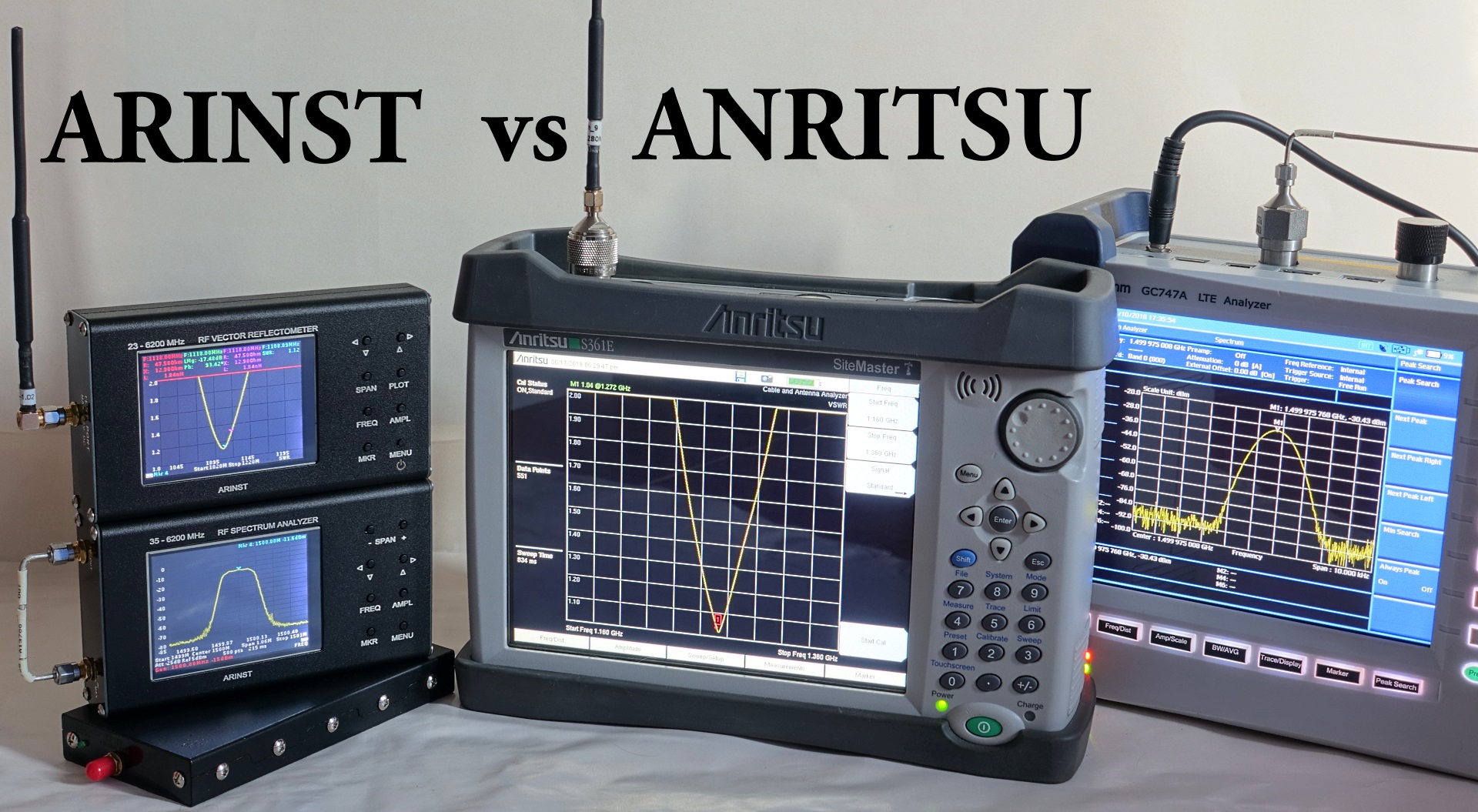
An independent test review received a pair of devices by the Russian developer Kroks. These are rather tiny radio frequency meters, namely: a spectrum analyzer with a built-in signal generator, and a vector network analyzer (reflectometer). Both devices at the highest frequency range up to 6.2 GHz.
There was an interest to understand whether these are regular pocket “display meters” (toys), or really worthy devices, because the manufacturer positions them: - “The device is intended for amateur radio use, since it is not a professional measuring device.”
For the attention of readers! These tests were conducted amateur, in no way pretending to metrological studies of measuring instruments, on the basis of the standards of the state registry and everything else related to this. Radio amateurs are interested in looking at comparative measurements of devices that are often used in practice (antennas, filters, attenuators), rather than theoretical “abstractions”, as is customary in metrology, for example: mismatched loads, inhomogeneous transmission lines, or short-circuit lines, in this test applied.
To avoid the influence of interference in the comparative measurement of antennas, an anechoic chamber, or open space, is required. In view of the absence of the first, measurements were taken outdoors, all antennas with directional light paths “looked” into the sky, being mounted on a tripod, without displacement in space when changing instruments.
The tests used a phase-stable coaxial measuring class feeder, Anritsu 15NNF50-1.5C, and N-SMA adapters from well-known companies: Midwest Microwave, Amphenol, Pasternack, Narda.
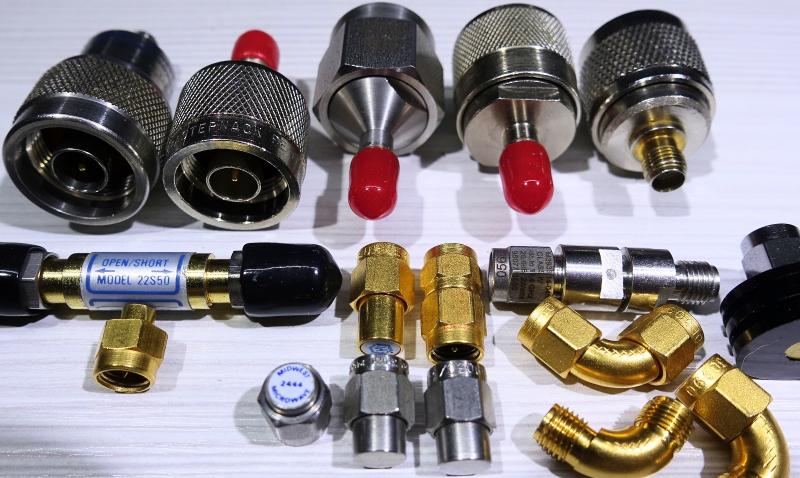
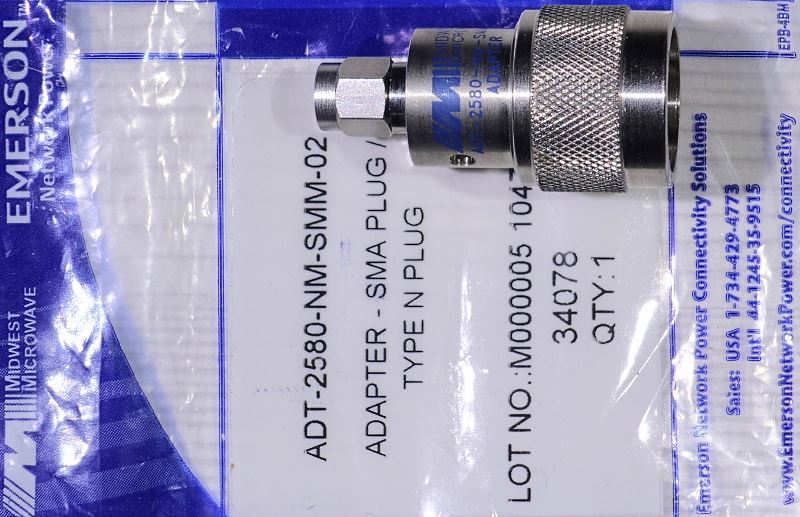
Cheap adapters made in China were not used, due to the frequent lack of repeatability of contact during reconnection, and also because of the shedding of the not strong antioxidant coating, which they used instead of the usual gilding ...
To obtain equal comparative conditions, before each measurement, the instruments were calibrated with the same set of OSL calibrators, in the same frequency band and current temperature range. OSL is “Open”, “Short”, “Load”, that is, a standard set of calibration measures: “idle measure”, “short circuit measure” and “50.0 Ohm matched load”, which are usually calibrated by vector network analyzers. For the SMA format, the Anritsu 22S50 calibration kit was used, normalized in the frequency range from DC to 26.5 GHz, a link to the datasheet (49 pages):
www.testmart.com/webdata/mfr_pdfs/ANRI/ANRITSU_COMPONENTS.pdfFor calibration of the N type format, respectively Anritsu OSLN50-1, normalized from DC to 6 GHz.
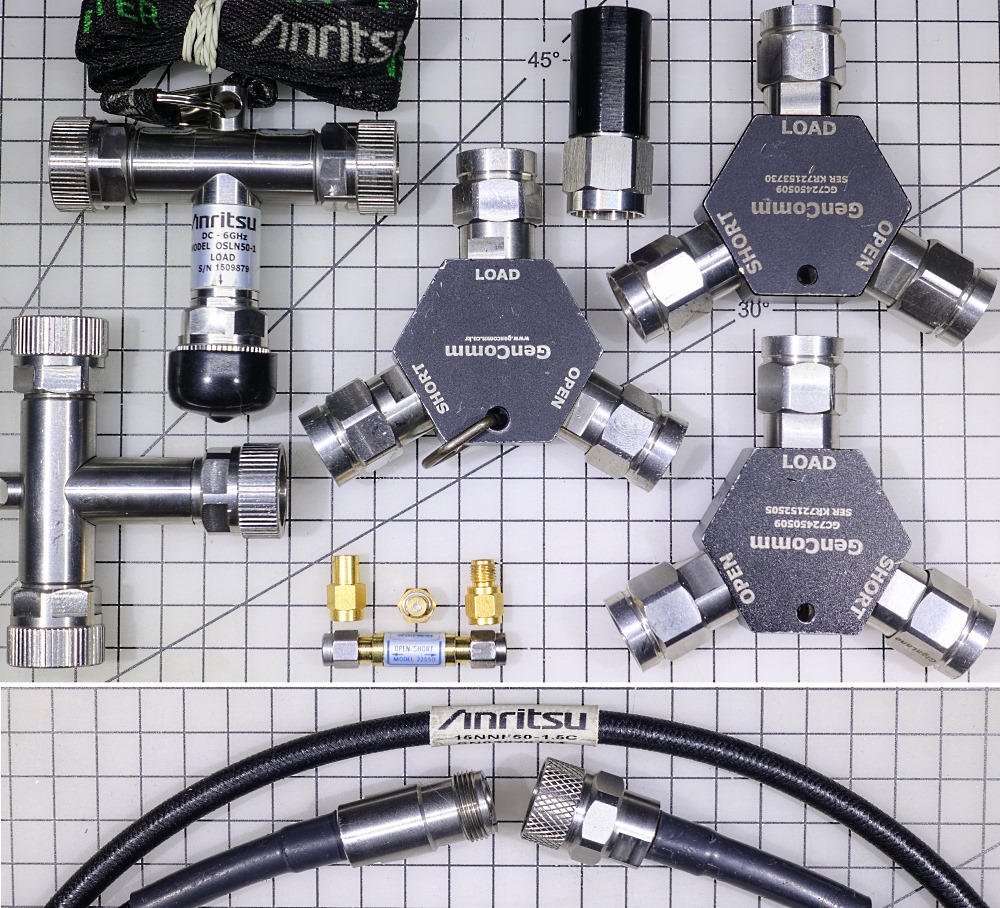
The measured resistance at the coordinated load of the calibrators was 50 ± 0.02 Ohm. The measurements were carried out by calibrated, precision laboratory-grade multimeters from HP and Fluke.
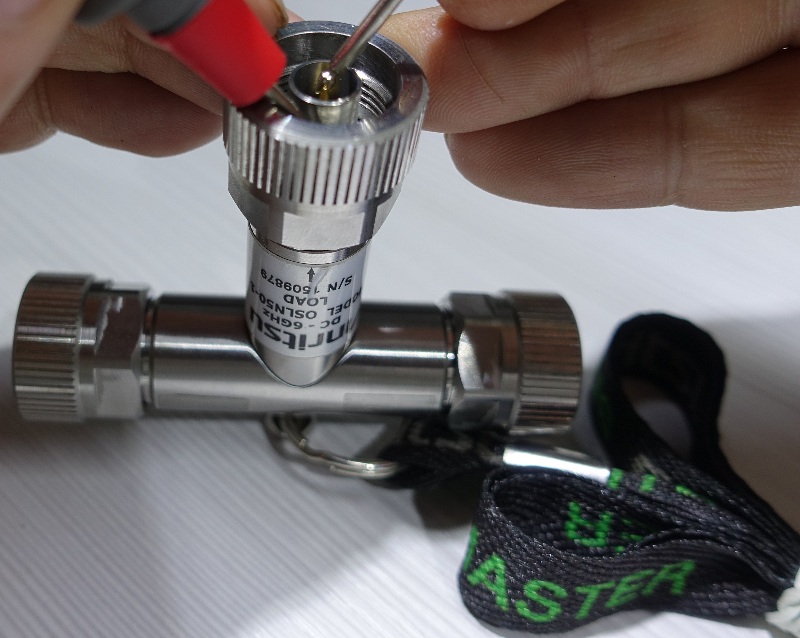
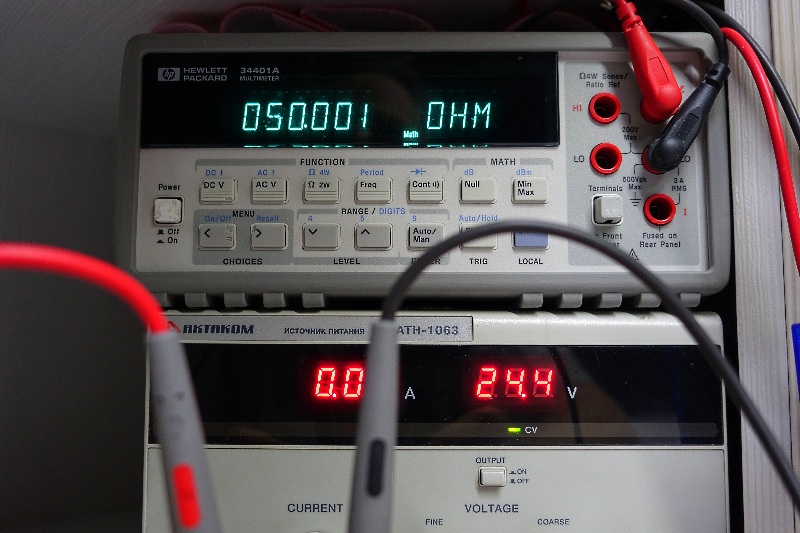
To ensure the best accuracy, as well as the most equal conditions in comparative tests, a similar bandwidth of the IF filter was installed on the devices, because the narrower this band, the higher the measurement accuracy and the signal-to-noise ratio. The largest number of scan points (closest to 1000) was also selected.
To familiarize yourself with all the functions of the considered reflectometer, there is a link to the illustrated, factory instructions:
arinst.ru/files/Manual_Vector_Reflectometer_ARINST_VR_23-6200_RUS.pdfBefore each measurement, all mating surfaces in coaxial connectors (SMA, RP-SMA, N type) were carefully checked, because at frequencies above 2-3 GHz, the cleanliness and condition of the antioxidant surface of these contacts begins to have a rather noticeable effect on the measurement results and stability their repeatability. It is very important to keep the outer surface of the central pin clean in the coaxial connector, and the inner surface of the collet mating with it in the mating half. All the same is true for “braided” contact. Such control and necessary cleaning is usually possible under a microscope, or under a high magnification lens.
It is also important to prevent the presence of crumbled metal chips on the surface of the insulators in the mating coaxial connectors, because they begin to introduce a stray capacitance, significantly interfering with the performance and signal transmission.
An example of a typical metallic clogging of SMA connectors that are not visible to the eye:
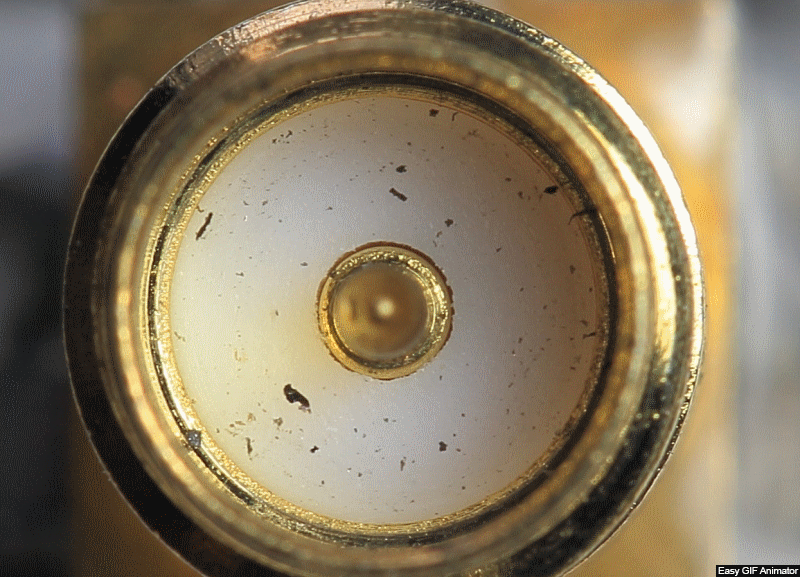
According to the factory requirements of manufacturers of microwave coaxial connectors with a threaded type of connection, when connecting, it is NOT possible to allow the central contact of the collet entering it to be turned. To do this, it is necessary to hold the axial base of the screw-on half of the connector, allowing rotation of only the nut itself, and not the entire screw-on structure. This significantly reduces scratching and other mechanical wear of the mating surfaces, providing better contact and extending the number of switching cycles.
Unfortunately, few amateurs know about this, but most of them screw it up entirely, each time scratching the already thin layer of the working surfaces of the contacts. Each time, numerous videos on Y. Tube, from the so-called "testers-testers" of the new microwave technology, testify to this.
In this test review, all the numerous connections of coaxial connectors and calibrators were carried out strictly in compliance with the above operational requirements.
In comparative tests, several different antennas were measured to check the reflectometer readings in different frequency ranges.
Comparison of the 7-element Uda-Yagi antenna of the 433 MHz band (LPD)
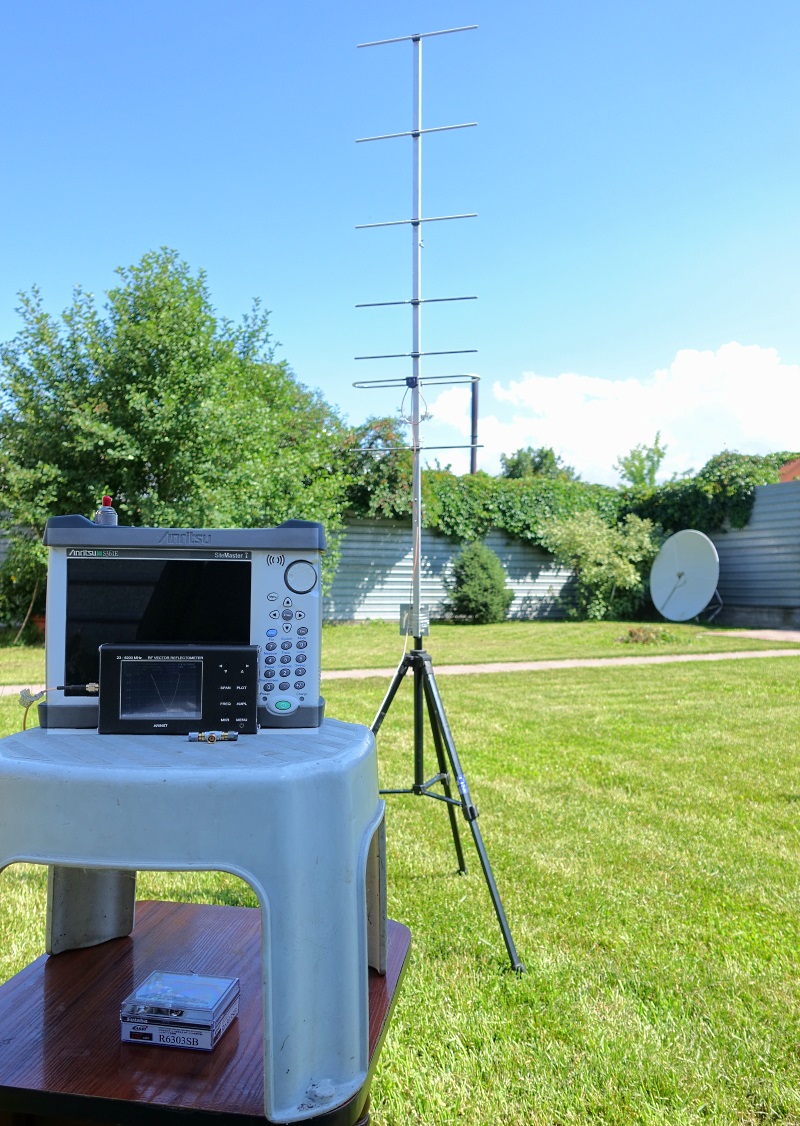
Since antennas of this type always have a rather pronounced back lobe, as well as several side lobes, for the purity of the test all environmental conditions of immobility were especially observed, up to locking the cat in the house. So that when photographing different modes on the displays, he would not noticeably end up in the coverage area of the back lobe, thereby introducing indignation into the graph.
The pictures contain photos from three devices, 4 modes each.
The top shot is from sabzhey VR 23-6200, the middle with Anritsu S361E, and the bottom with GenCom 747A.
VSWR Charts:
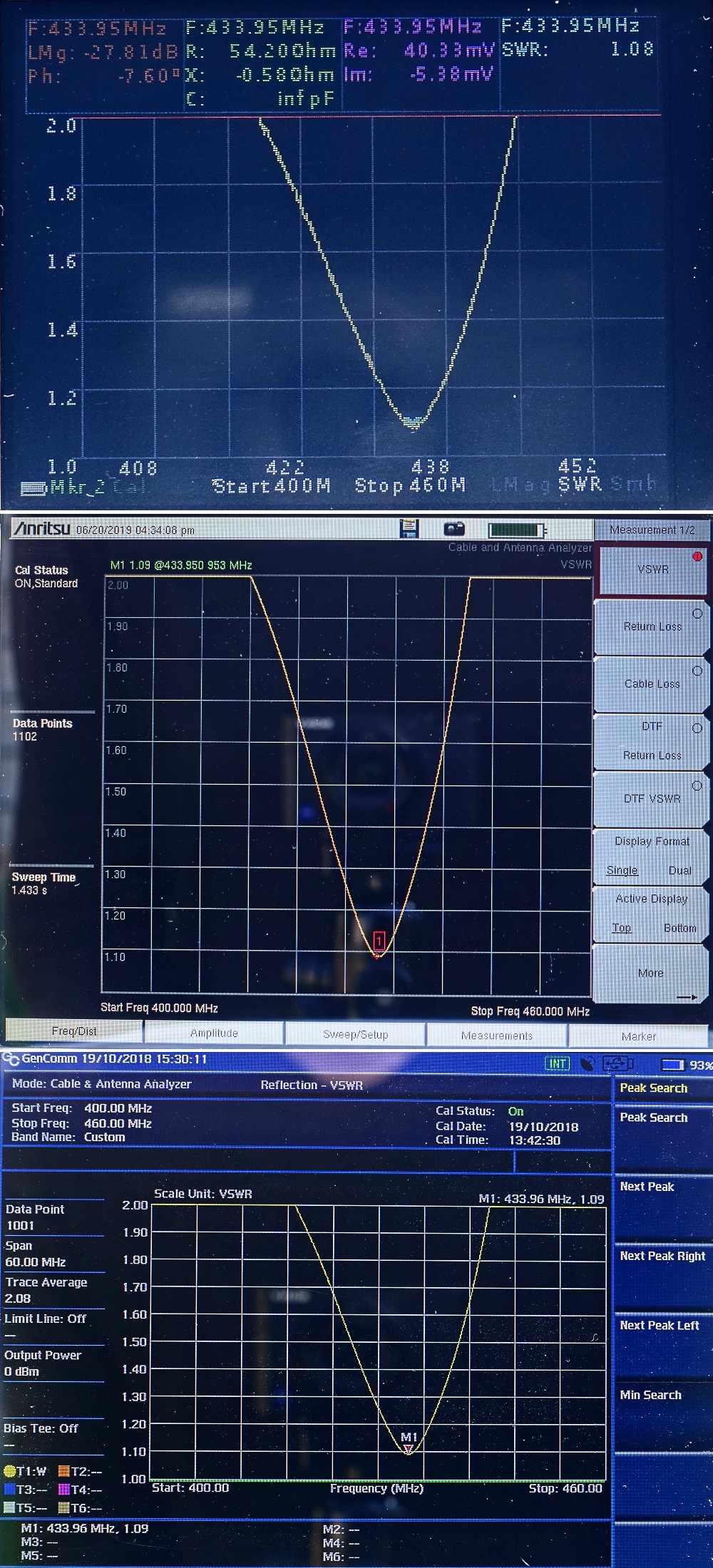
Graphs of reflected losses:
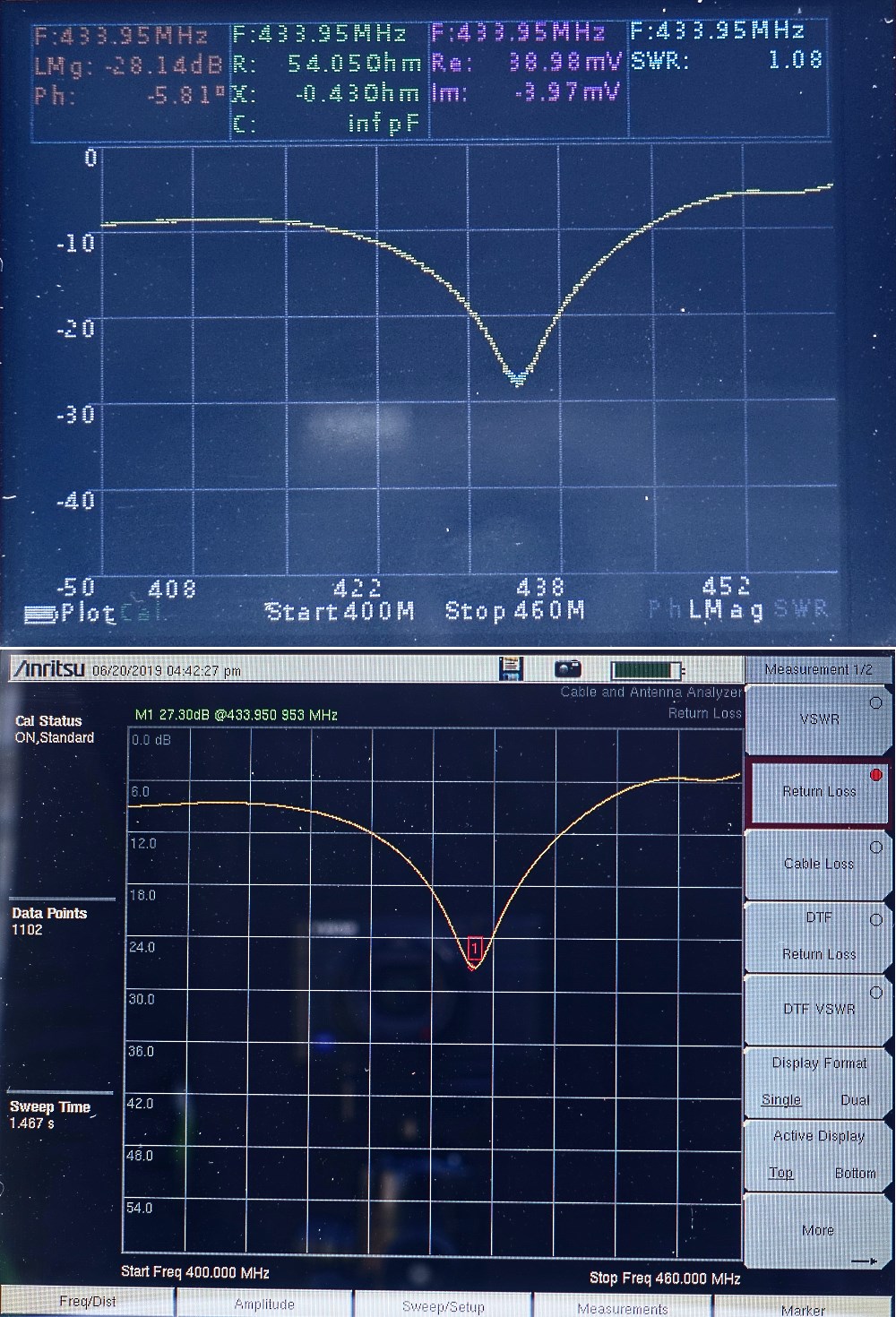
Wolpert-Smith Impedance Charts:

Phase graphs:
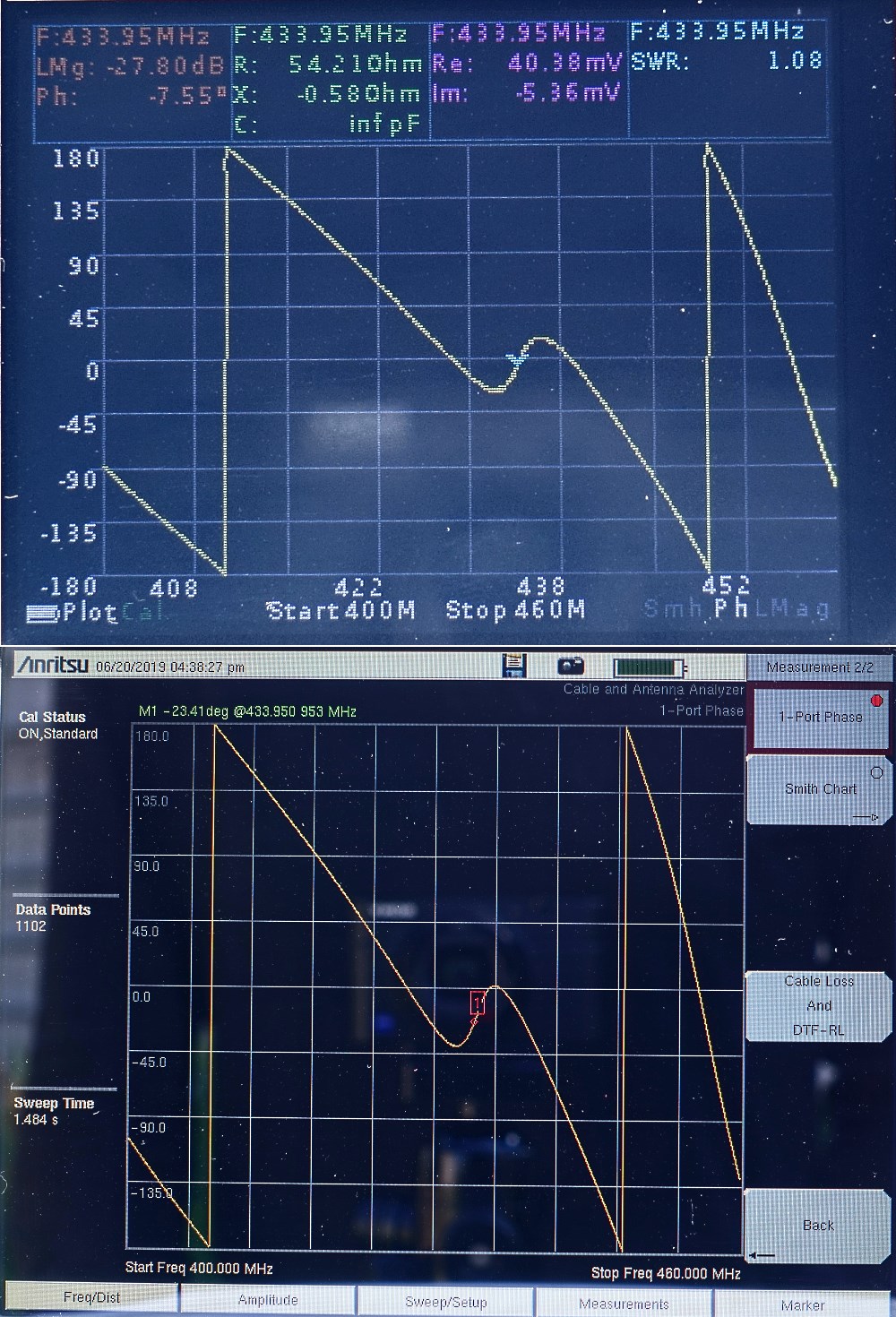
As you can see, the resulting graphs are very similar, and the measurement values have a spread within 0.1% of the error.
1.2 GHz Coaxial Dipole Comparison
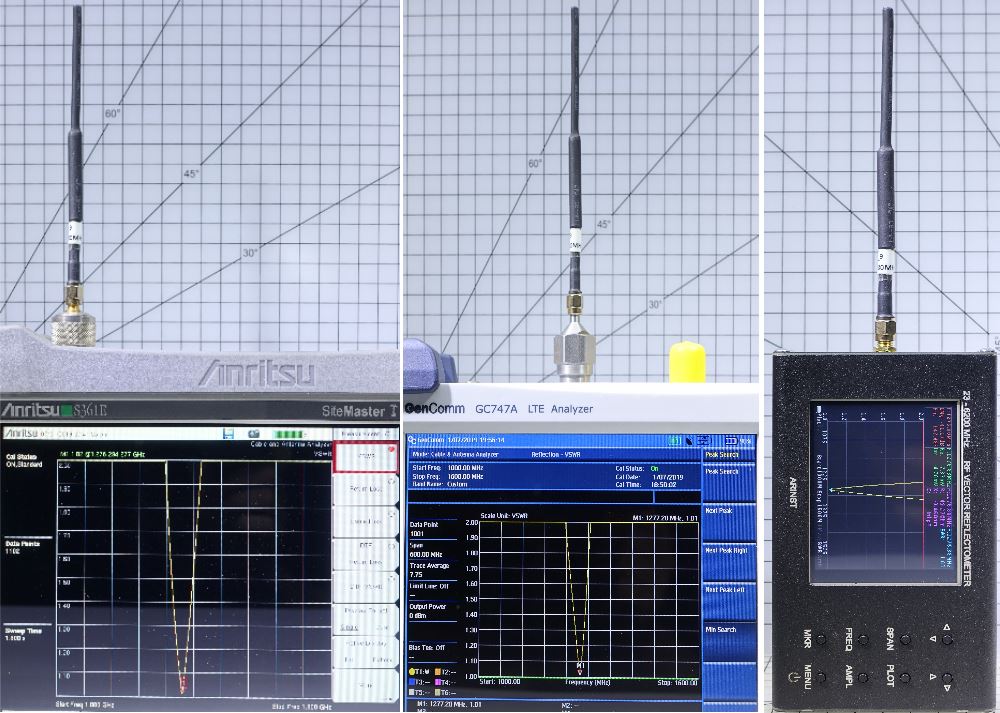
VSWR:
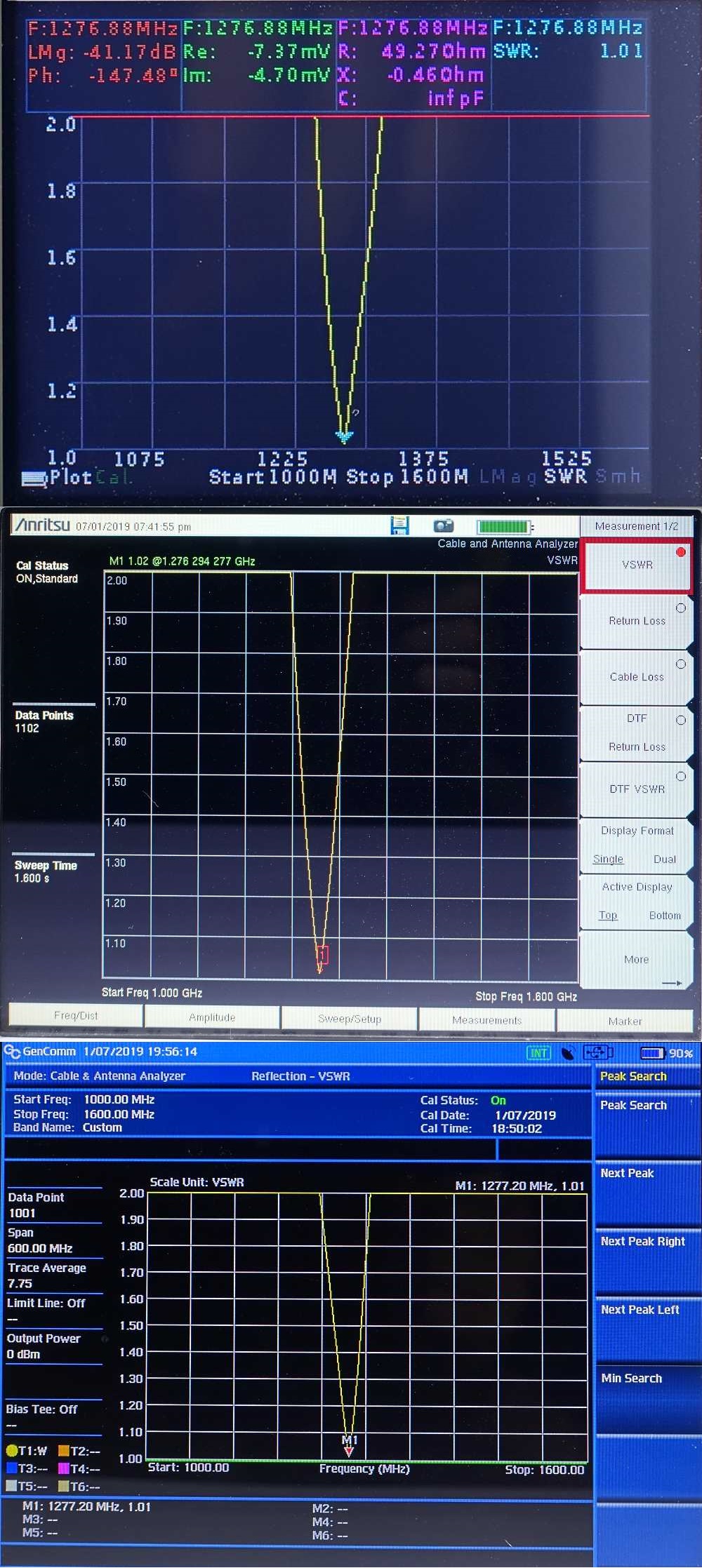
Return Loss:
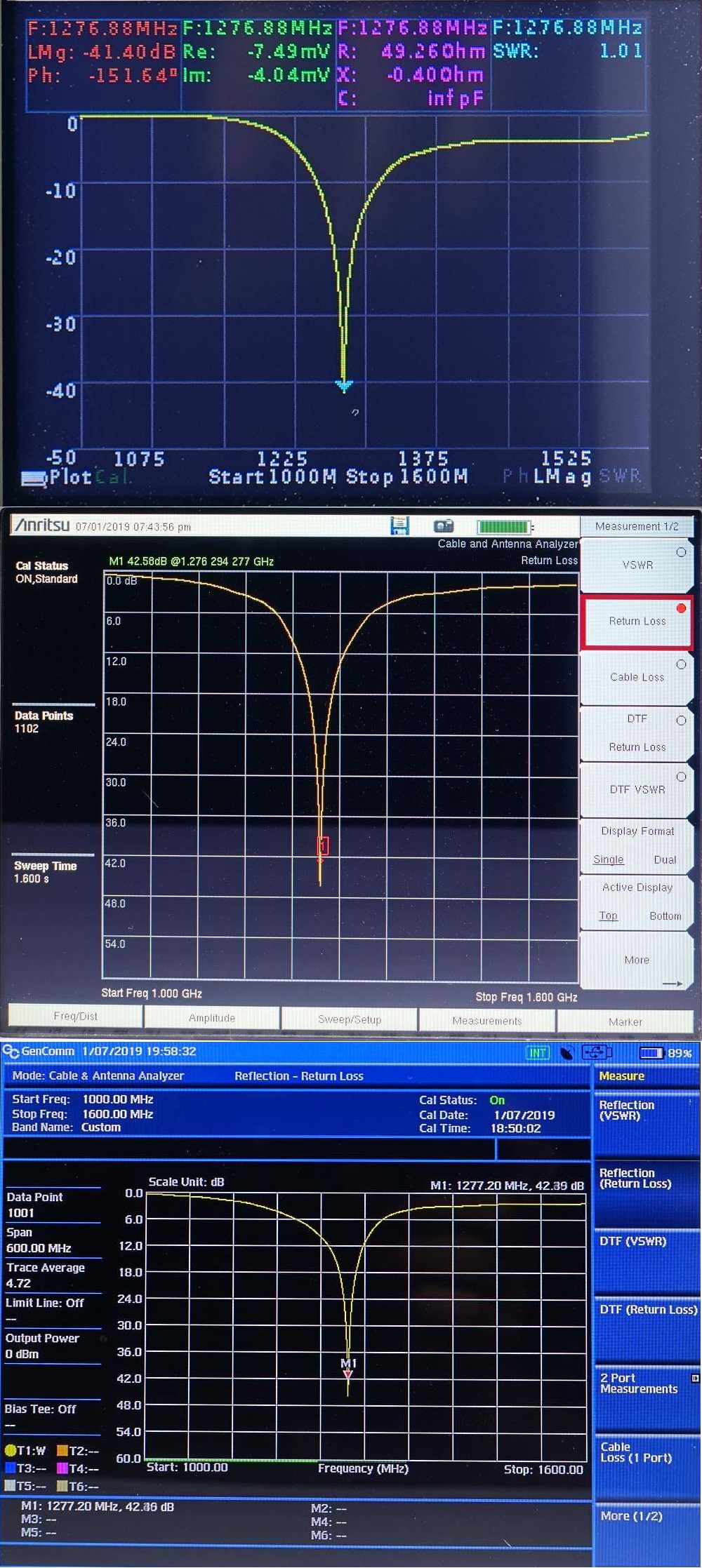
Wolpert-Smith Chart:
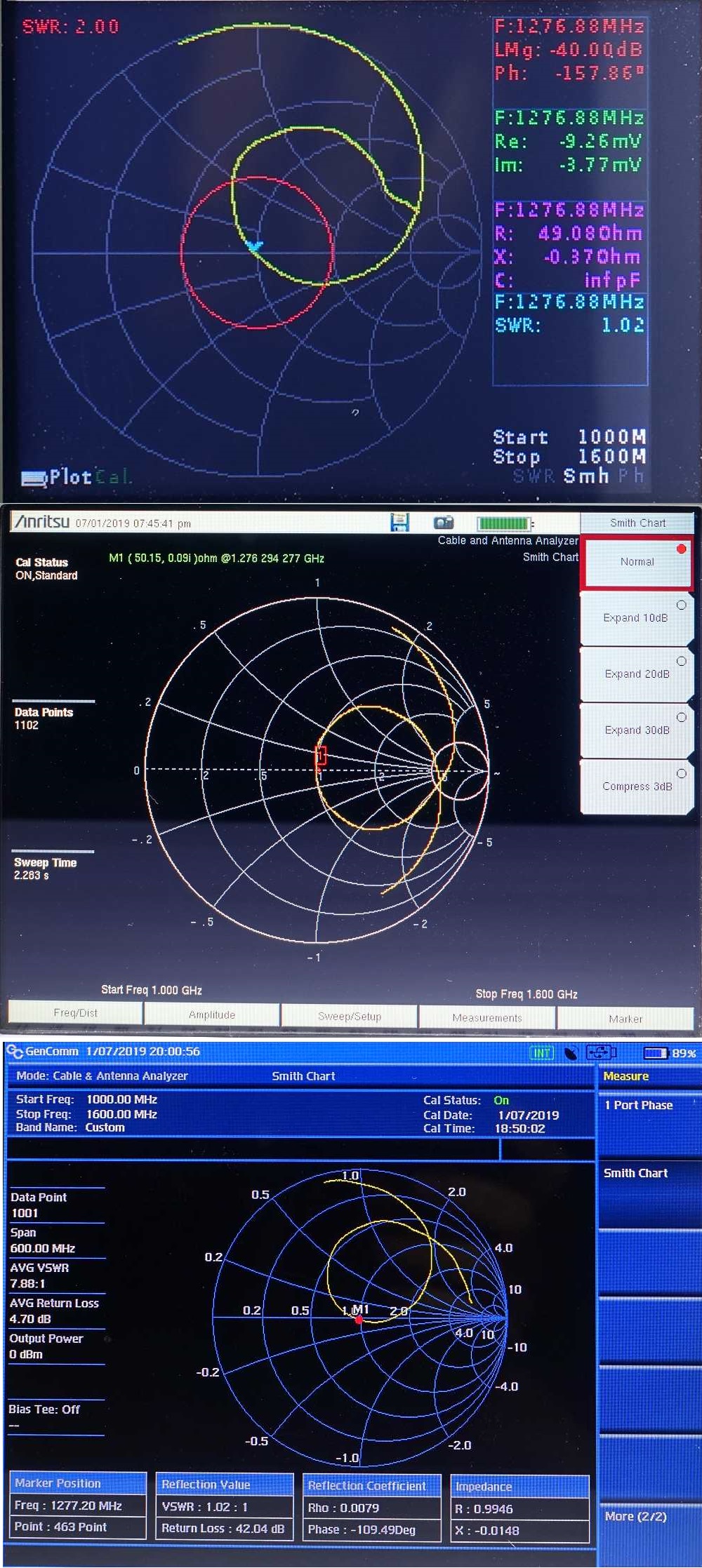
Phase:

Here, too, all three devices according to the measured resonance frequency of this antenna were within 0.07%.
3-6 GHz horn antenna comparison
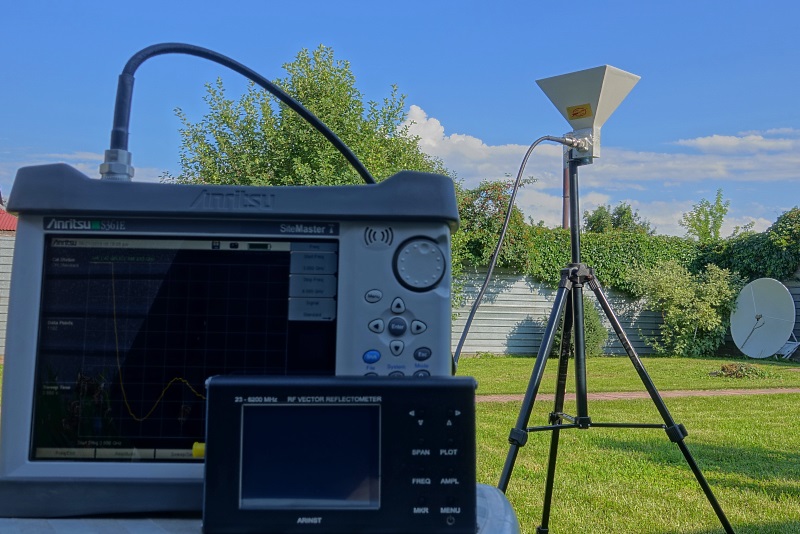
An extension cable with N-type connectors was used here, which slightly introduced a non-uniformity in the measurements. But since the task was simply to compare the devices, and not the cable or antenna, then if there was a problem in the path, then the devices should show it as it is.
Calibration of the measuring (reference) plane taking into account the adapter and feeder:
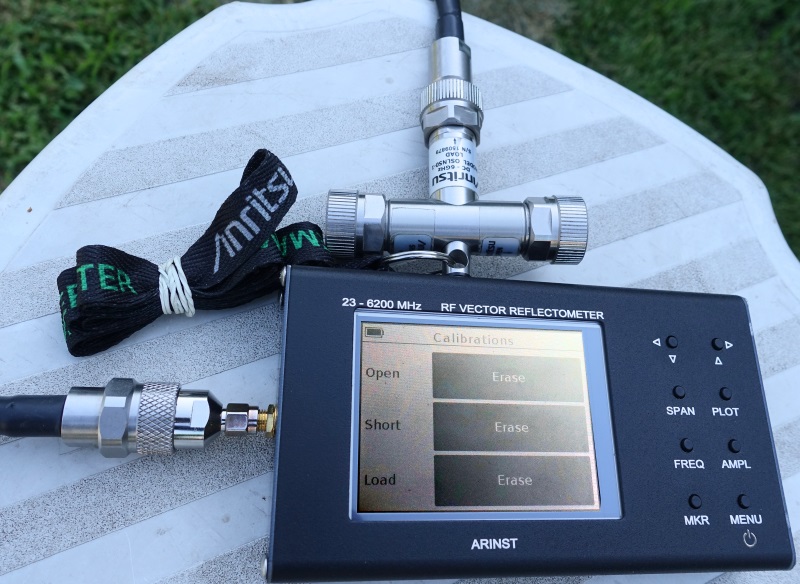
VSWR in the band from 3 to 6 GHz:

Return Loss:
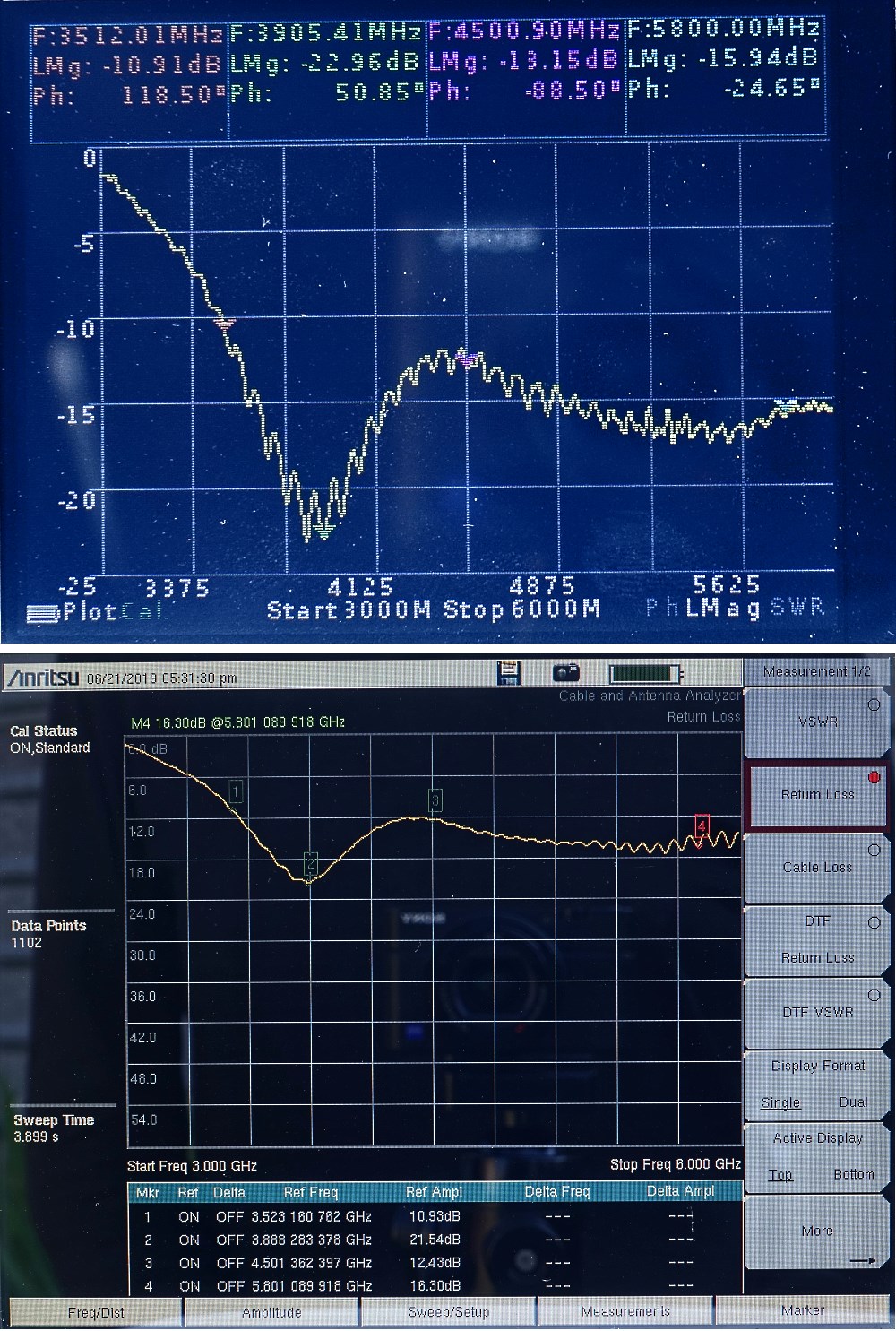
Wolpert Smith Chart:
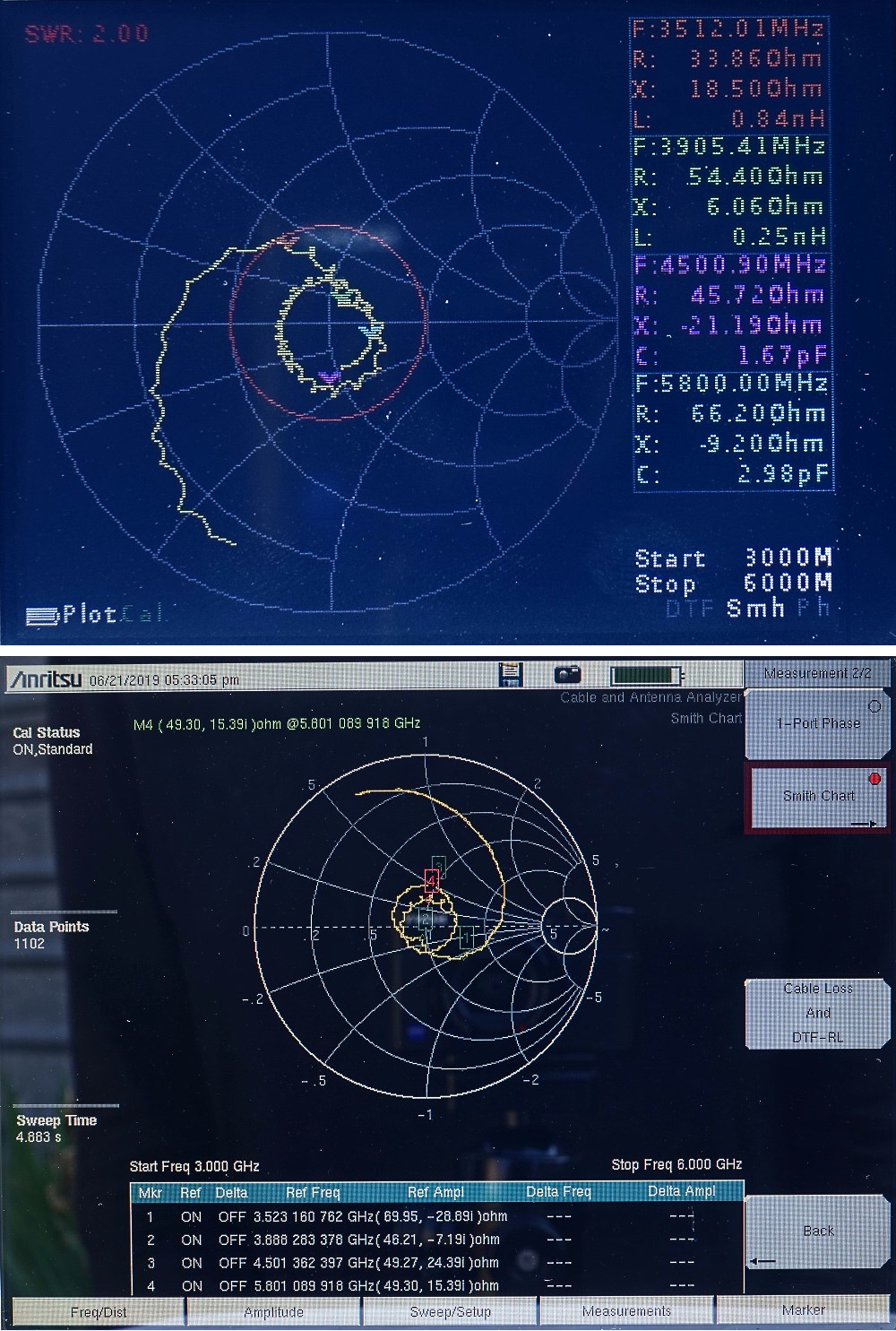
Phase graphs:
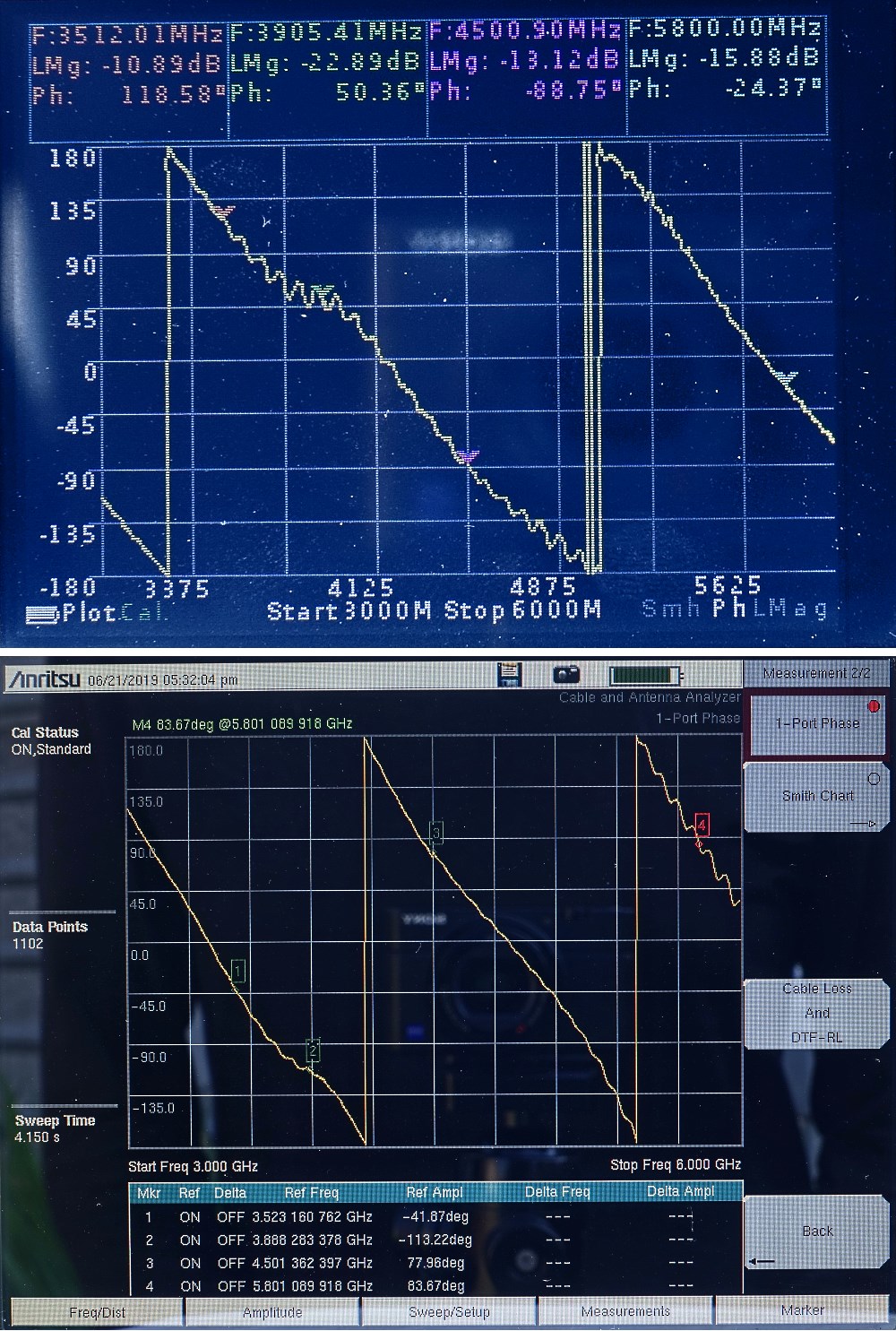
Comparison of the circular polarization antenna of the 5.8 GHz band
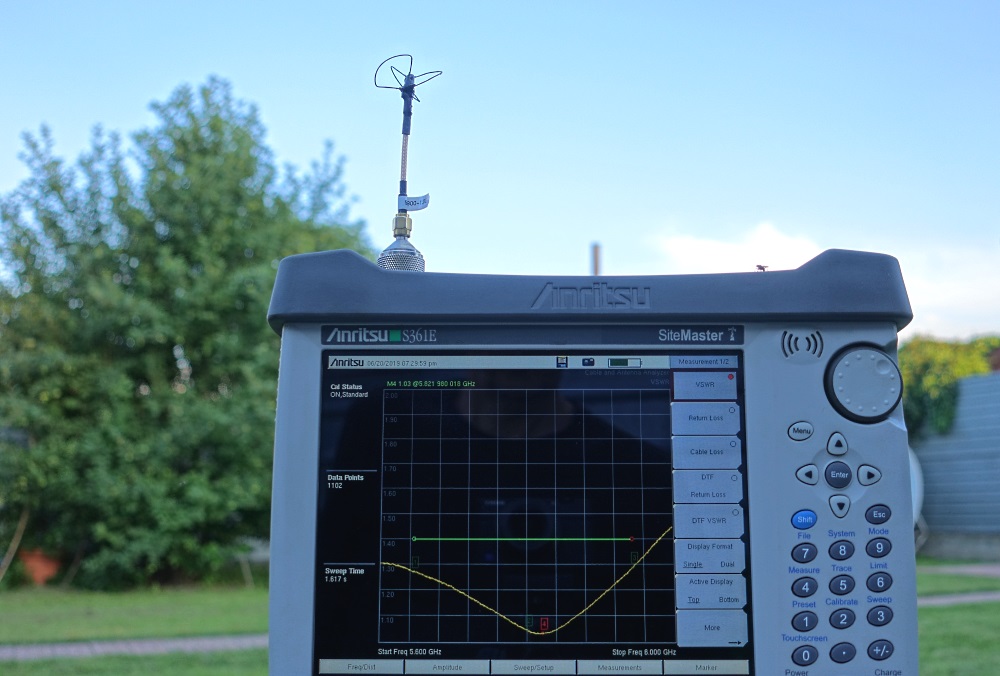
VSWR:
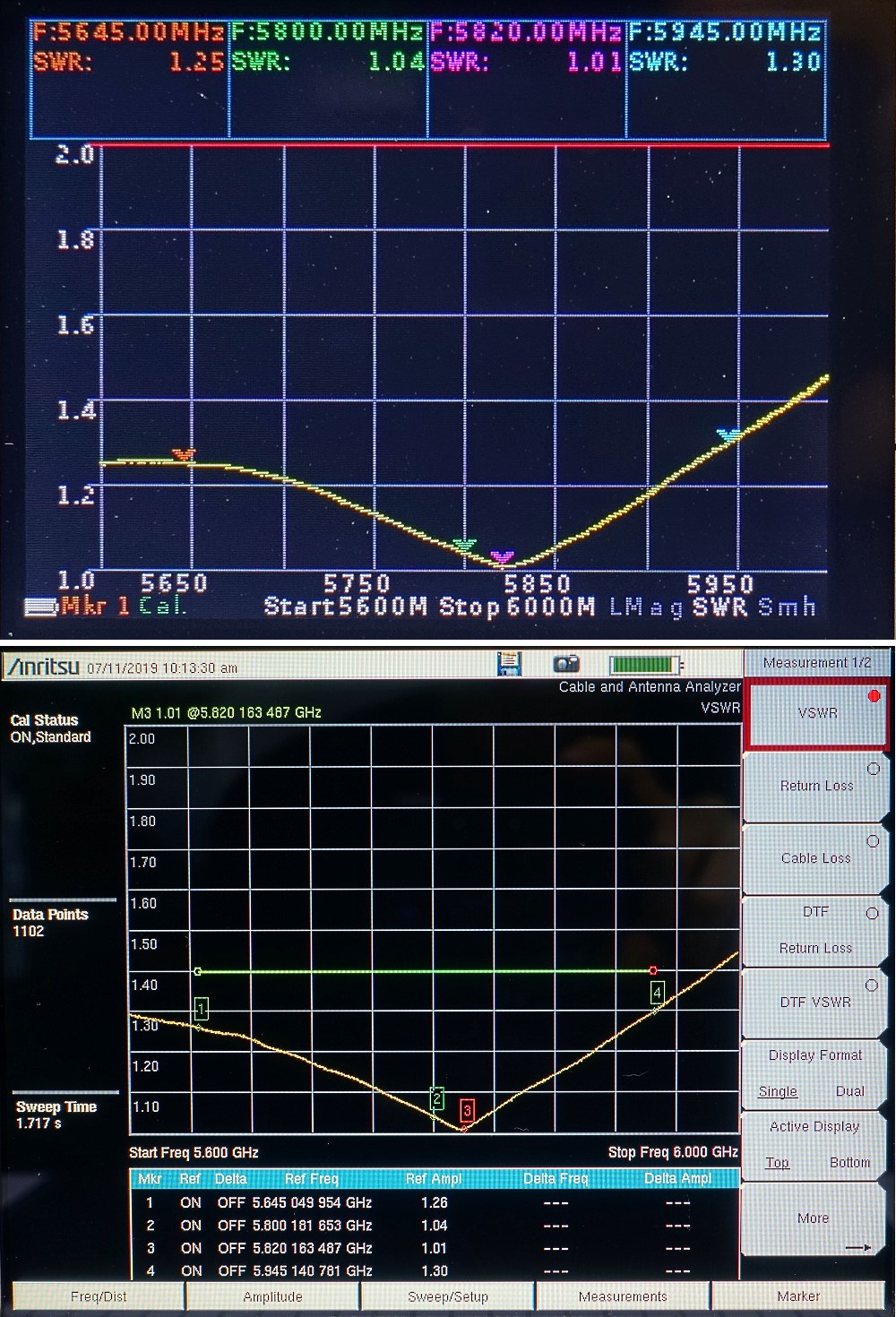
Return Loss:
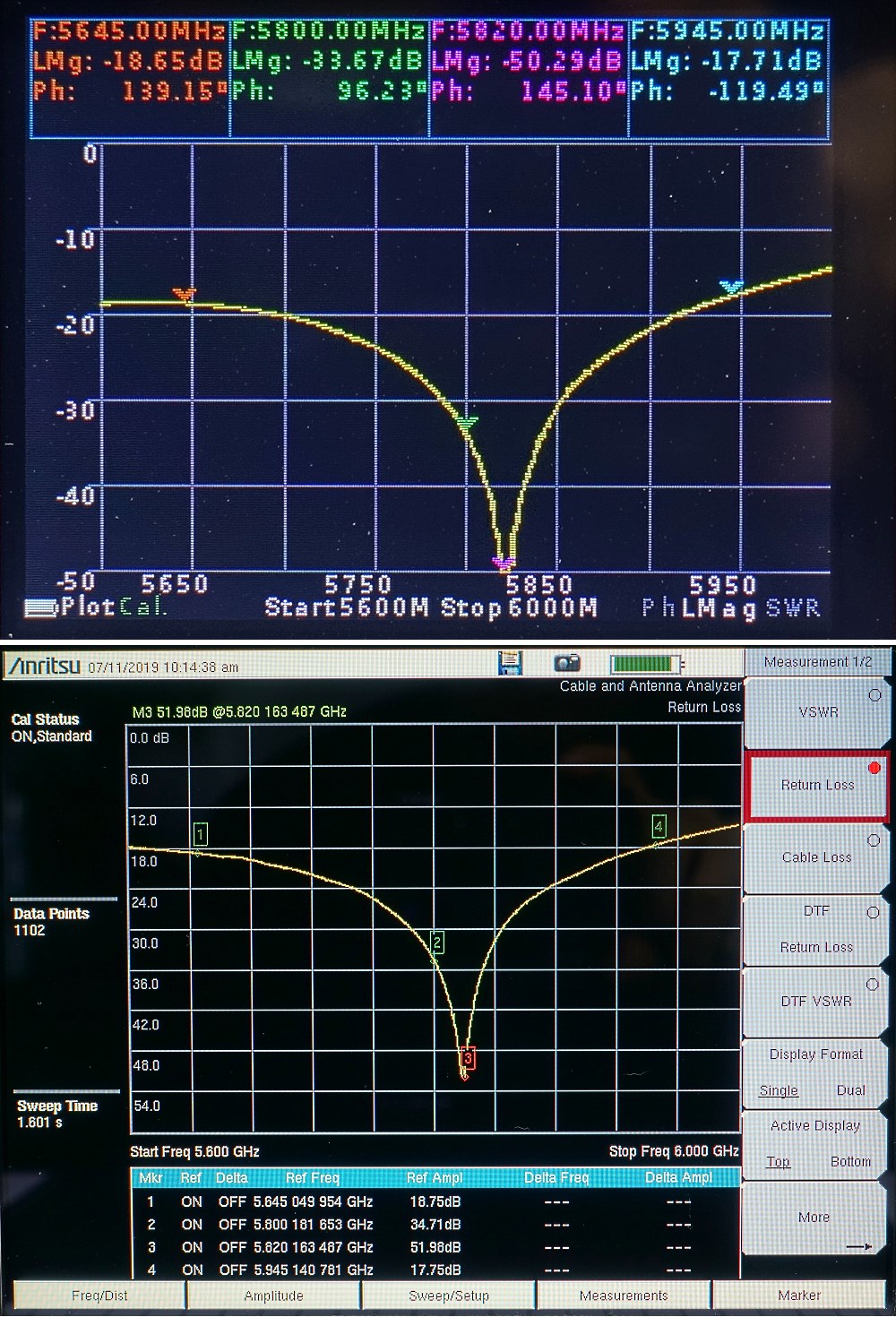
Wolpert-Smith Chart:
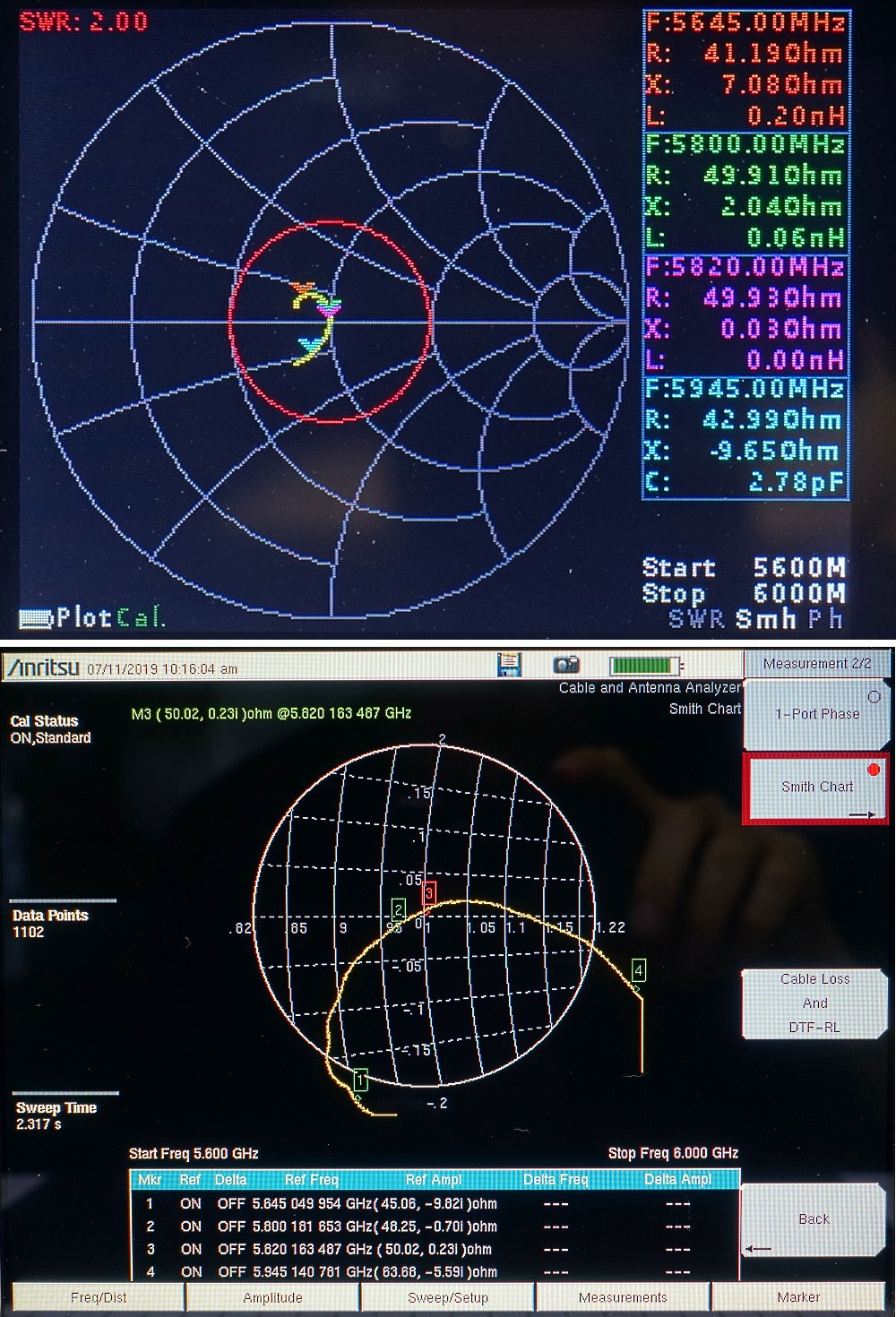
Phase:
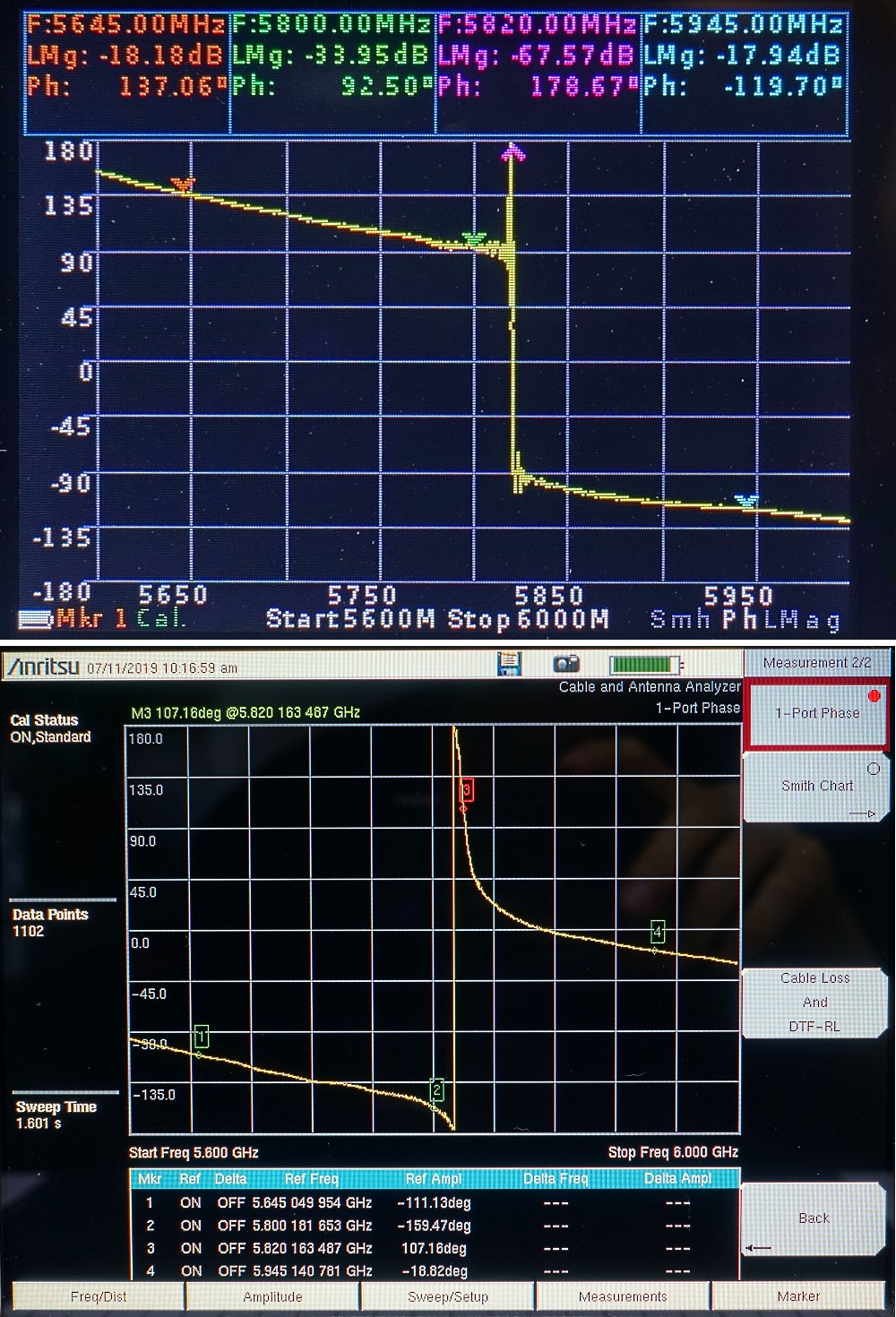
Comparative measurement of VSWR of the Chinese LPF filter 1.4 GHz
Filter Appearance:

VSWR Charts:
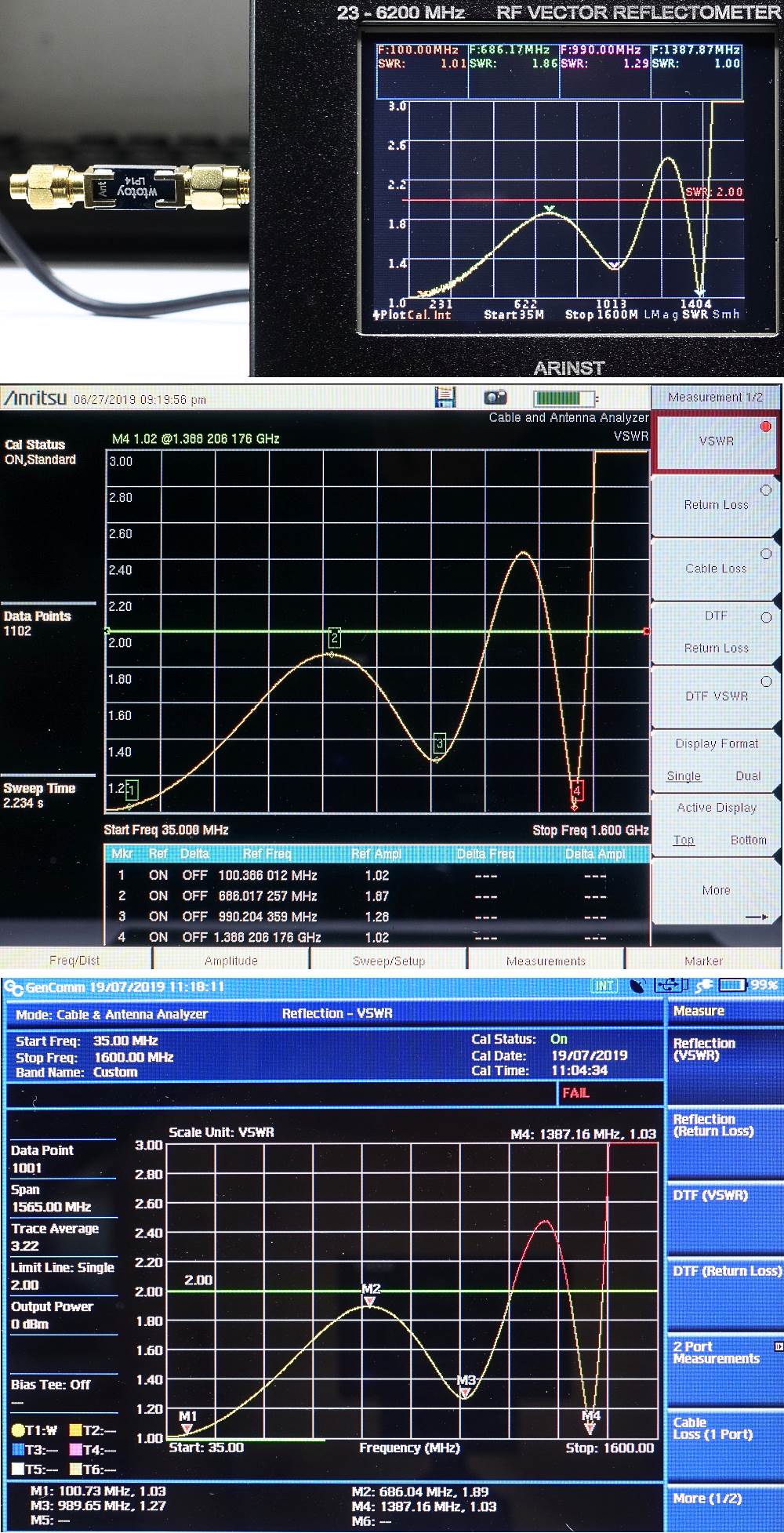
Comparative Feeder Length Measurement (DTF)
I decided to measure a new coaxial cable, with N type connectors:
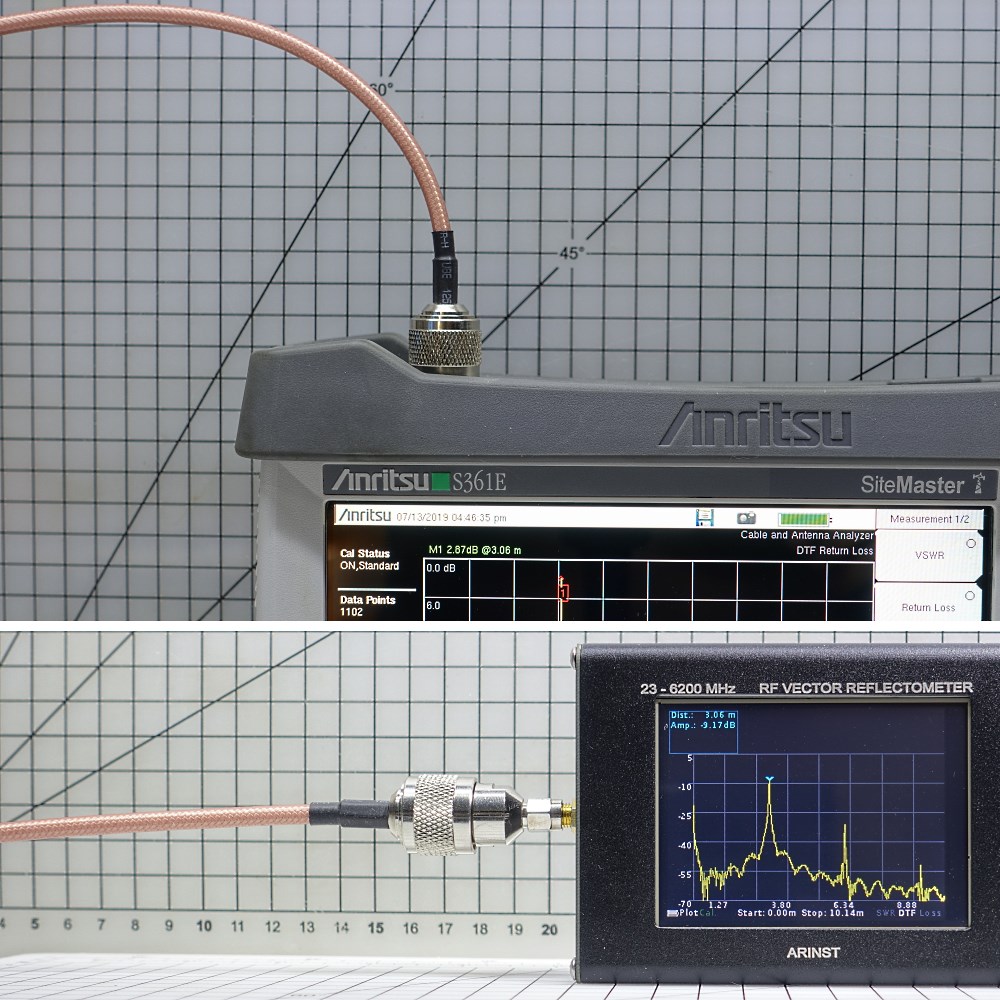
Two-meter tape measure in three steps, measured 3 meters 5 centimeters.
But what the devices showed:
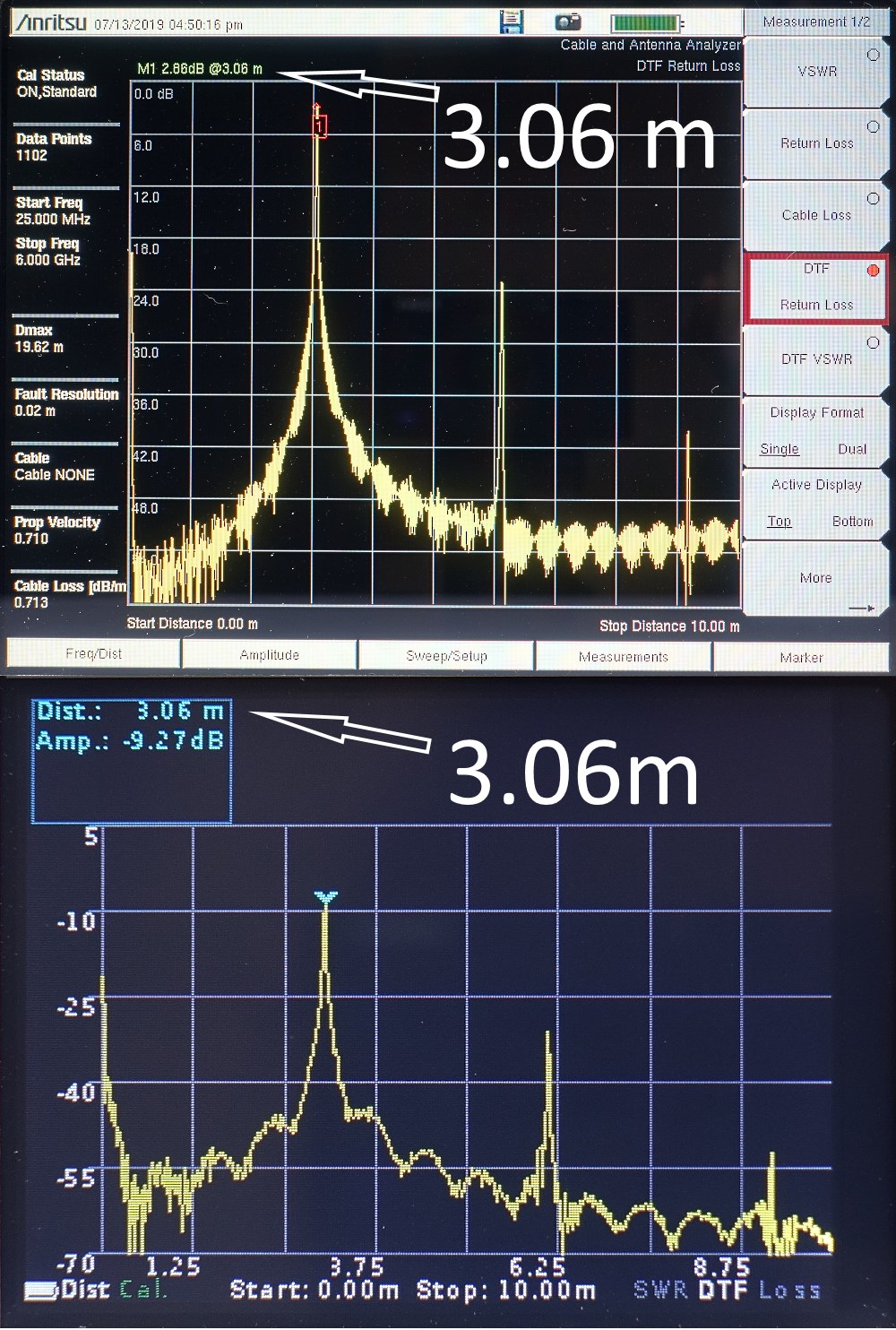
Here, as they say, comments are superfluous.
Comparison of accuracy of the built-in tracking generator
On this gif picture, 10 photos of the readings of the frequency meter Ch3-54 are collected. The upper halves of the pictures are the testimony of test subject VR 23-6200. The lower halves are signals from an Anritsu reflectometer. Five frequencies were chosen for the test: 23, 50, 100, 150 and 200 MHz. If Anritsu served the frequency with zeros in the lower digits, then compact VR served with a slight excess, numerically increasing with increasing frequency:
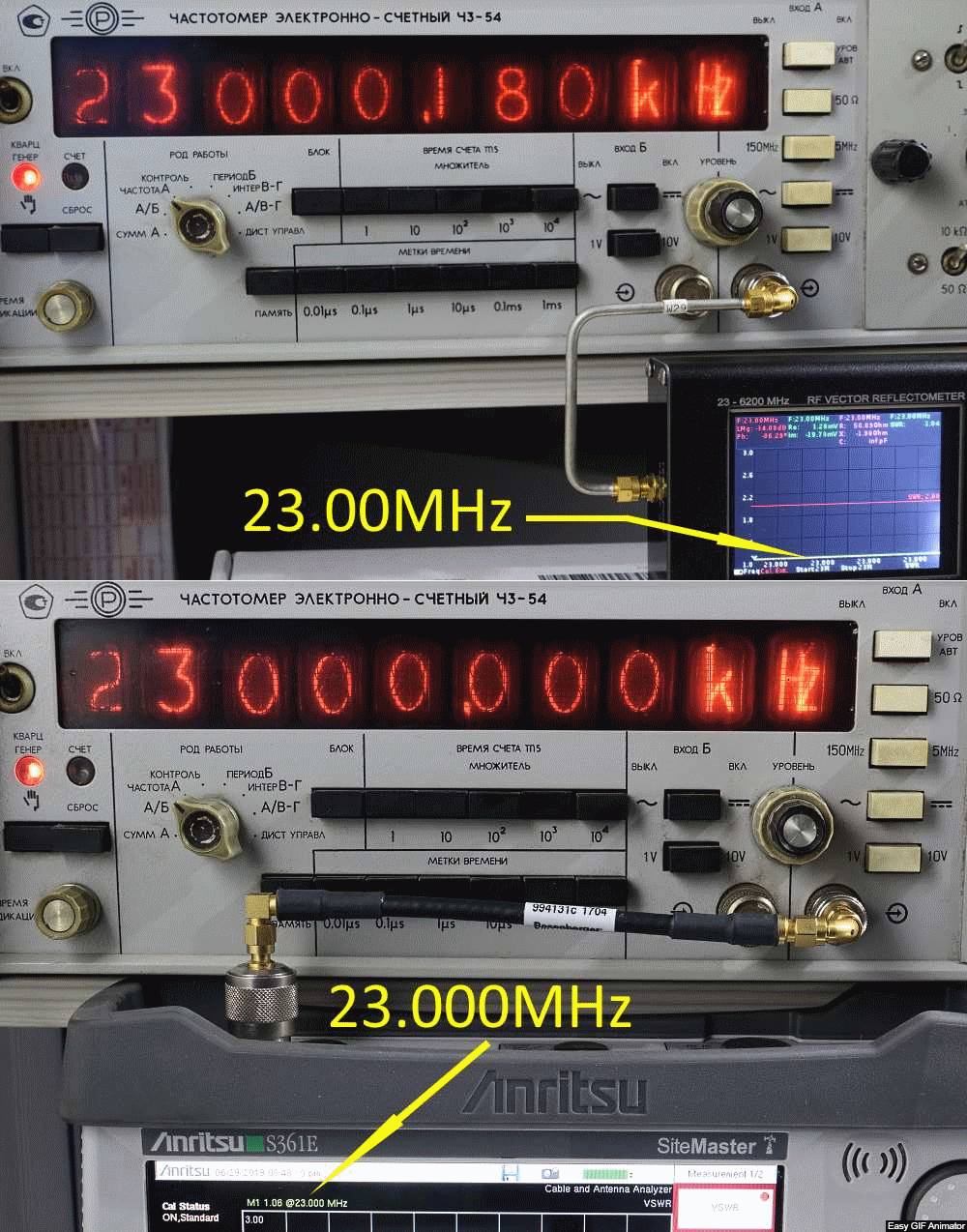
Although according to the technical characteristics of the manufacturer, this cannot be a “minus”, because it does not go beyond the declared two categories, after the decimal sign.
Pictures collected in a gif about the internal "decoration" of the device:
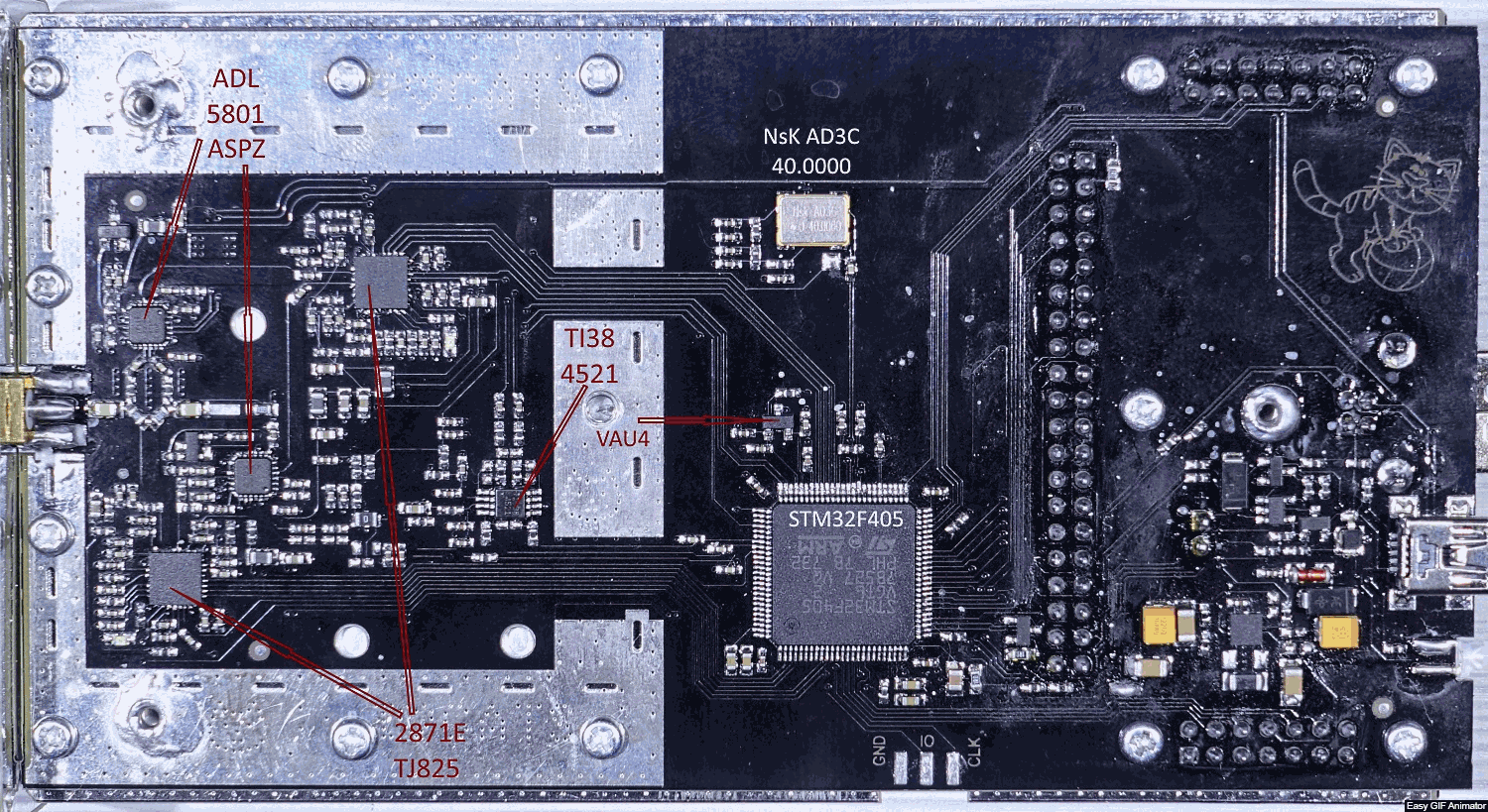
Pros:
The advantages of the VR 23-6200 are its low cost, portable compactness with full autonomy, which does not require an external display from a computer or smartphone, with a fairly wide frequency range displayed in the marking. You can also add the fact that this is not a scalar, but a fully-fledged vector meter. As can be seen from the results of comparative measurements, VR is practically not inferior to large, famous and not very cheap devices. In any case, climb onto the roof (or mast) to clarify the condition of the feeders and antennas, it is preferable with such a baby than with a larger and heavier apparatus. And for the 5.8 GHz band that has now become fashionable for FPV racing (radio-controlled flying multicopter and airplanes, with on-board video broadcasting to glasses or displays), it’s a must have. Since it allows directly on the flights it is easy to select the optimal antenna from the spare ones, or even straighten and adjust the antenna crumpled after the crash of a racing flying machine on the go. The device can be said to be “pocket-sized,” and with a low dead weight it can easily hang even on a thin feeder, which is convenient for many field work.
Cons also seen:
1) The OTDR’s greatest operational drawback is the inability to quickly find the minimum or maximum on the chart, not to mention the search for the “delta”, or the auto-search for subsequent (or previous) minima / maxima.
Especially often this is in demand in the LMag and SWR modes, there is a lack of such marker management capabilities. You have to activate the marker in the corresponding menu, and later manually move the marker to the minimum of the curve in order to calculate the frequency and magnitude of the SWR at that point. Perhaps in subsequent firmware the manufacturer will add such a function.
1 a) Also, the device does not know how to reassign the desired display mode for markers when switching between measurement modes.
For example, I switched from VSWR mode to LMag (Return Loss), and the markers still show the value of VSWR, while logically they should display the magnitude of the reflection modulus in dB, that is, what the currently selected graph shows.
The same is true in all other modes. In order to read the values corresponding to the selected chart in the marker table, each time it is necessary to manually reassign the display mode for each of the 4 markers. It seems to be a trifle, but I would like a little “automatism”.
1 b) In the most popular VSWR measurement mode, the amplitude scale cannot be switched to a more detailed one, less than 2.0 (for example, 1.5, or 1.3).
2) There is a small feature in inconsistent calibration. As if always “open”, or “parallel” calibration. That is, there is no sequential ability to record a calibrator measure read, as is customary on other VNA devices. Usually in the calibration mode, the device successively prompts itself which one the (next) calibration measure should be installed right now and read it out for accounting.
And at ARINST, at the same time, the right to choose all three clicks of the measure record is granted, which imposes an increased requirement of attention from the operator when carrying out the next calibration stage. Although I have never been confused, but to press a button that does not correspond to the end of the calibrator connected at the moment, there is an easy possibility of making such an error.
Perhaps in subsequent firmware upgrades, the creators of such an open "parallelism" of choice, "change" the same in the "sequence", to exclude a possible error from the operator. After all, it is no accident that large instruments used precisely a clear sequence of actions with calibration measures, just to exclude such an error from confusion.
3) Very narrow calibration temperature range. If after calibration, Anritsu is provided with a range (for example) from + 18 ° to + 48 ° , then on Arinst it is only ± 3 ° from the calibration temperature, which may be small during field work (outdoors), in the sun, or in the shadows.
For example: calibrated after lunch, and you work with measurements until the evening, the sun has gone, the temperature has dropped and the readings have gone wrong.
For some reason, a stop message doesn’t pop up saying that they say “recalibrate due to going beyond the temperature range of the previous calibration”. Instead, erroneous measurements begin with a biased zero, which significantly affects the measurement result.
For comparison, here's how the Anritsu reflectometer reports this:
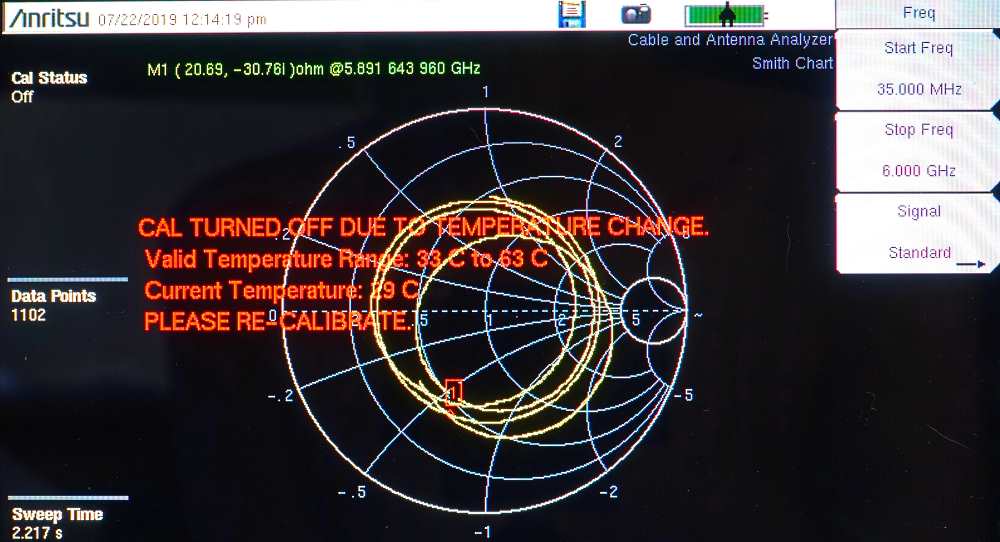
4) The room is normal, but for an open area a very dim display.
On a sunny day, nothing is readable on the street, even if you shade the screen with your palm.
Adjusting the brightness of the display is not provided at all.
5) I want to solder the hardware buttons to others, since some do not immediately work out the presses.
6) The touchscreen in some places is not responsive, but in some places too sensitive.
Conclusions on the VR 23-6200 OTDR
If you do not cling to the minuses, then in comparison with other budget, portable and freely available solutions on the market, such as RF Explorer, N1201SA, KC901V, RigExpert, SURECOM SW-102, NanoVNA - this Arinst VR 23-6200 looks like the most successful choice. Because for others, either the price is already not quite budgetary, or in the frequency band they are limited and thus not universal, or in fact they are toy-type displays. Despite the modesty and relatively low price, the VR 23-6200 vector reflectometer turned out to be a surprisingly decent device, and even so portable. If the manufacturers had modified the minuses in it and slightly expanded the lower frequency edge for short-wave radio enthusiasts, then the device would have occupied the podium among all the world public sector employees of this purpose, for coverage would be affordable: from “KaVe to eFeVe”, that is, from 2 MHz for HF (160 meters), up to 5.8 GHz for FPV (5 centimeters). And preferably without gaps in the entire strip, not as an example as it was on RF Explorer:
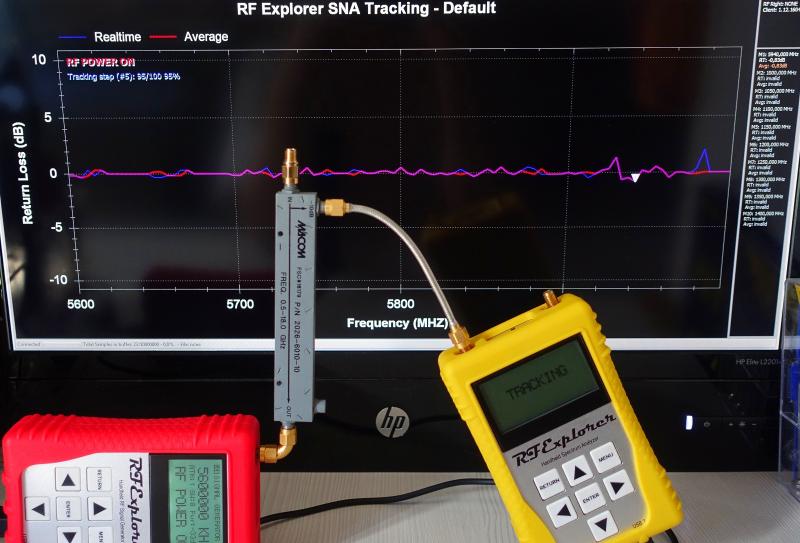
Undoubtedly, sooner cheaper solutions will certainly appear in such a wide frequency range, and it will be great! But so far (at the time of June-July 2019), in my humble opinion, this reflectometer is the best in the world among portable and not expensive, commercially available offers.
-
Part twoSpectrum Analyzer with Tracking Generator SSA-TG R2The second device is no less interesting than a vector reflectometer.
It allows you to measure "through" the parameters of various microwave devices in the mode of 2-port measurements (type S21). For example, you can test the performance and accurately measure the gain of boosters, amplifiers, or the amount of signal attenuation (loss) in attenuators, filters, coaxial cables (feeders), and other active and passive devices and modules, which cannot be done with a single-port reflectometer.
This is a full spectrum analyzer, in a very wide and continuous frequency range, which is far from common among inexpensive amateur equipment. In addition, there is a built-in tracking generator of radio frequency signals, also in a wide range. Also needed help to the OTDR and antenna meter. This allows you to see if there are carrier frequency deviations in the transmitters, spurious intermodulation, clipping, etc.
And having a tracking generator and a spectrum analyzer, adding an external directional coupler (or bridge), it becomes possible to measure the same SWR antenna, though only in the scalar measurement mode, without taking into account the phase, as it would be on a vector one.
Link to factory instructions:
This device was mainly compared with the combined measuring complex GenCom 747A, with a limit on the upper frequency to 4 GHz. Also, a new power meter of the precision class Anritsu MA24106A participated in the tests, with correction tables wired at the factory for the measured frequency and temperature, normalized to 6 GHz in frequency.
Own noise shelf of the spectrum analyzer, with a matched “dummy” at the input:
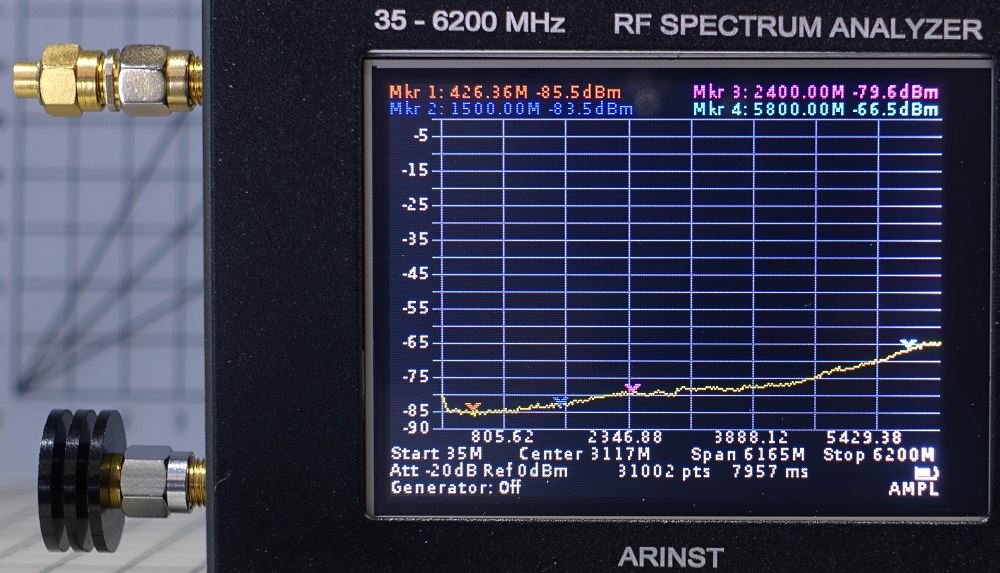
A minimum of -85.5 dB was in the region of the LPD (426 MHz).
Further, with increasing frequency, the noise threshold also increases slightly, which is quite natural:
1500 MHz - 83.5 dB. 2400 MHz - 79.6 dB. At 5800 MHz - 66.5 dB.
Measurement of the gain of the active Wi-Fi booster, based on the XQ-02A module
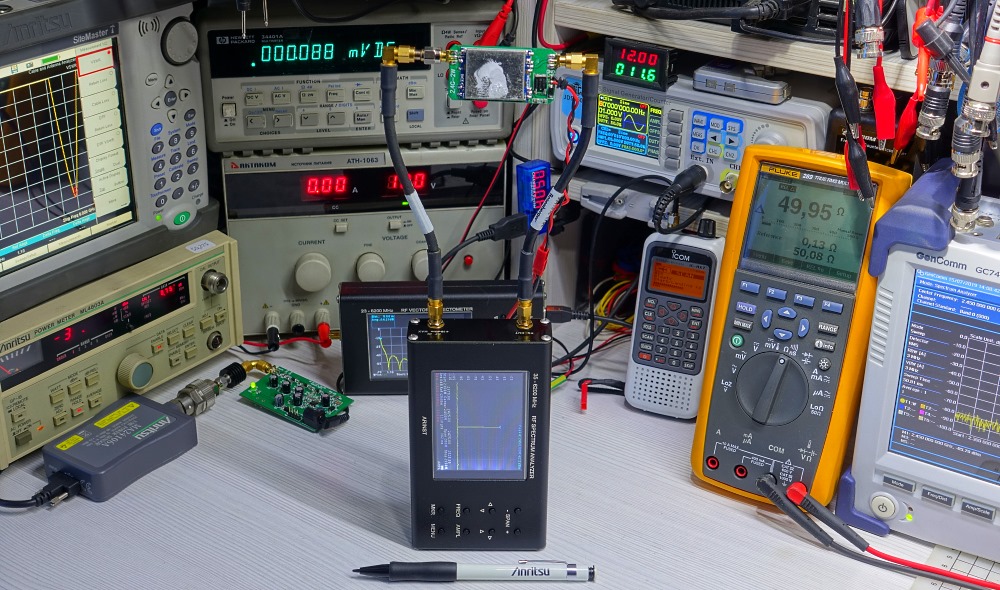
A feature of this booster is an automatic switch, which, when supplied, does not immediately keep the amplifier in the on state. Experimentally sorting out the attenuators on a large device, we managed to find out the threshold for turning on the built-in automation. It turned out that the booster switches to the active state and begins to amplify the transmitted signal only if it is more than minus 4 dBm (0.4 mW):
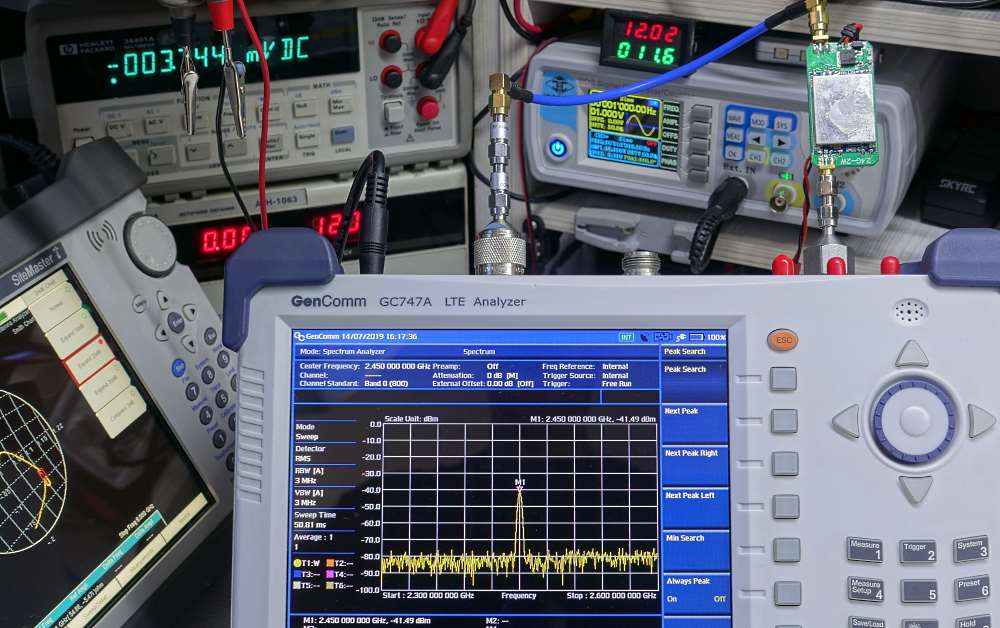
For this test, the small device simply did not have the output level of the built-in generator, which has a adjustment range documented in the TTX, from minus 15 to minus 25 dBm. And here it was necessary already minus 4, which is much more than minus 15. Yes, it was possible to use an external amplifier, but the task was different.
With a large device, I measured the KU of the included booster, it turned out to be 11 dB, in accordance with the performance characteristics.
For that, a small device managed to find out the amount of attenuation on the off booster, but with the power supplied. It turned out that a de-energized booster 12,000 times attenuated the transmitted signal to the antenna. For this reason, once flying and forgetting to supply power to the external booster in a timely manner, the long-range hexacopter flying 60-70 meters stopped and switched to auto-return to the take-off point. Then there was a need to know the magnitude of the pass through attenuation of the turned off amplifier. It turned out to be about 41-42 dB.
1-3500 MHz noise generator
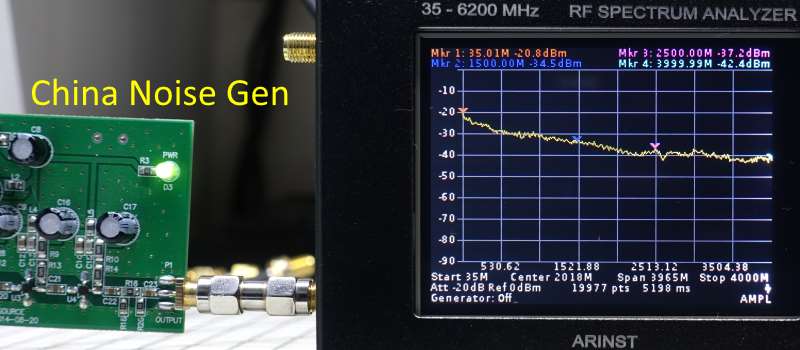
A simple amateur-made noise generator in China.
A linear comparison of readings in dB is somewhat inappropriate here, in view of the constant change in amplitude at different frequencies, caused by the very nature of the noise.
But nevertheless, both devices managed to remove very similar, comparative graphs of the frequency response:
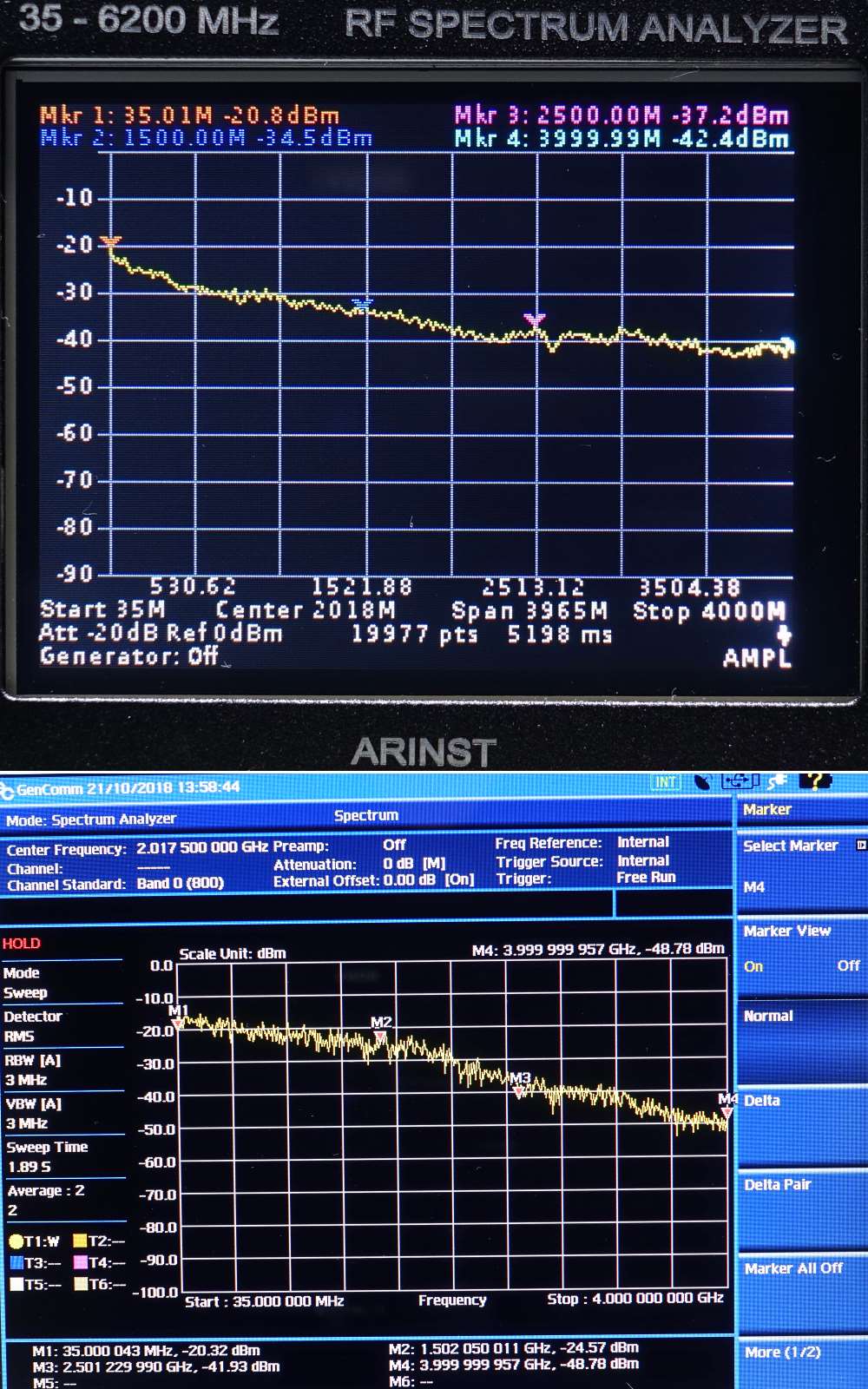
Here the frequency range on the devices was set equal, from 35 to 4000 MHz.
And in amplitude, as you can see, quite similar values are also obtained.
Feed-through frequency response (measurement S21), LPF 1.4 filter
In the first half of the review, this filter was already mentioned. But there was measured its VSWR, and here the frequency response of the transmission, where it is clearly visible what and with what attenuation it misses, as well as where and how much it cuts.
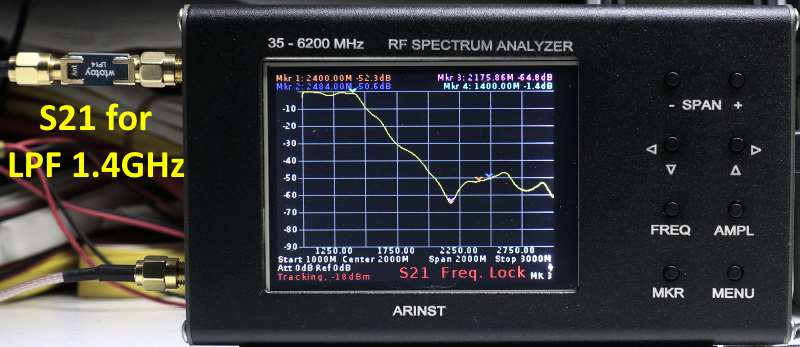
Here it can be seen in more detail that both devices almost equally removed the frequency response of this filter:

At a cut-off frequency of 1400 MHz, Arinst showed an amplitude of minus 1.4 dB (blue marker Mkr 4), and GenCom minus 1.79 dB (marker M5).
Attenuator Attenuation Measurement
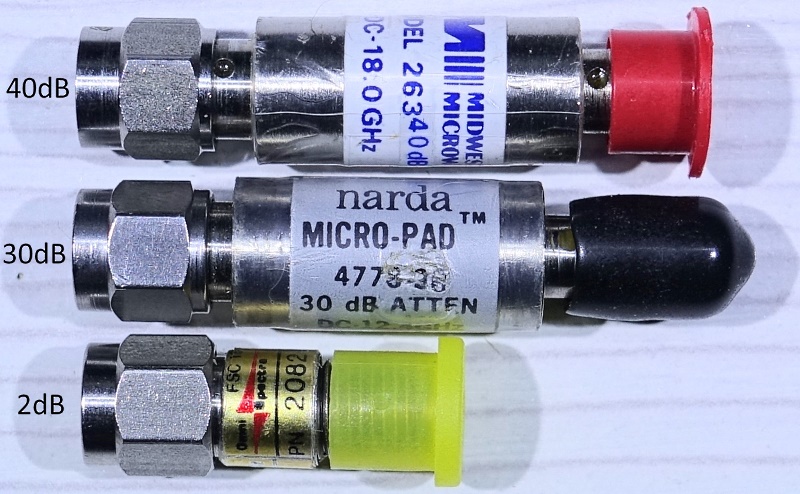
For comparative measurements, I chose the most accurate, branded attenuators. Specially not Chinese, in view of their rather large scatter.
The frequency range is still equal, from 35 to 4000 MHz. Calibration of the two port measurements was carried out just as carefully, with the obligatory control of the degree of surface cleanliness of all contacts on the mating coaxial connectors.
0 dB calibration result:
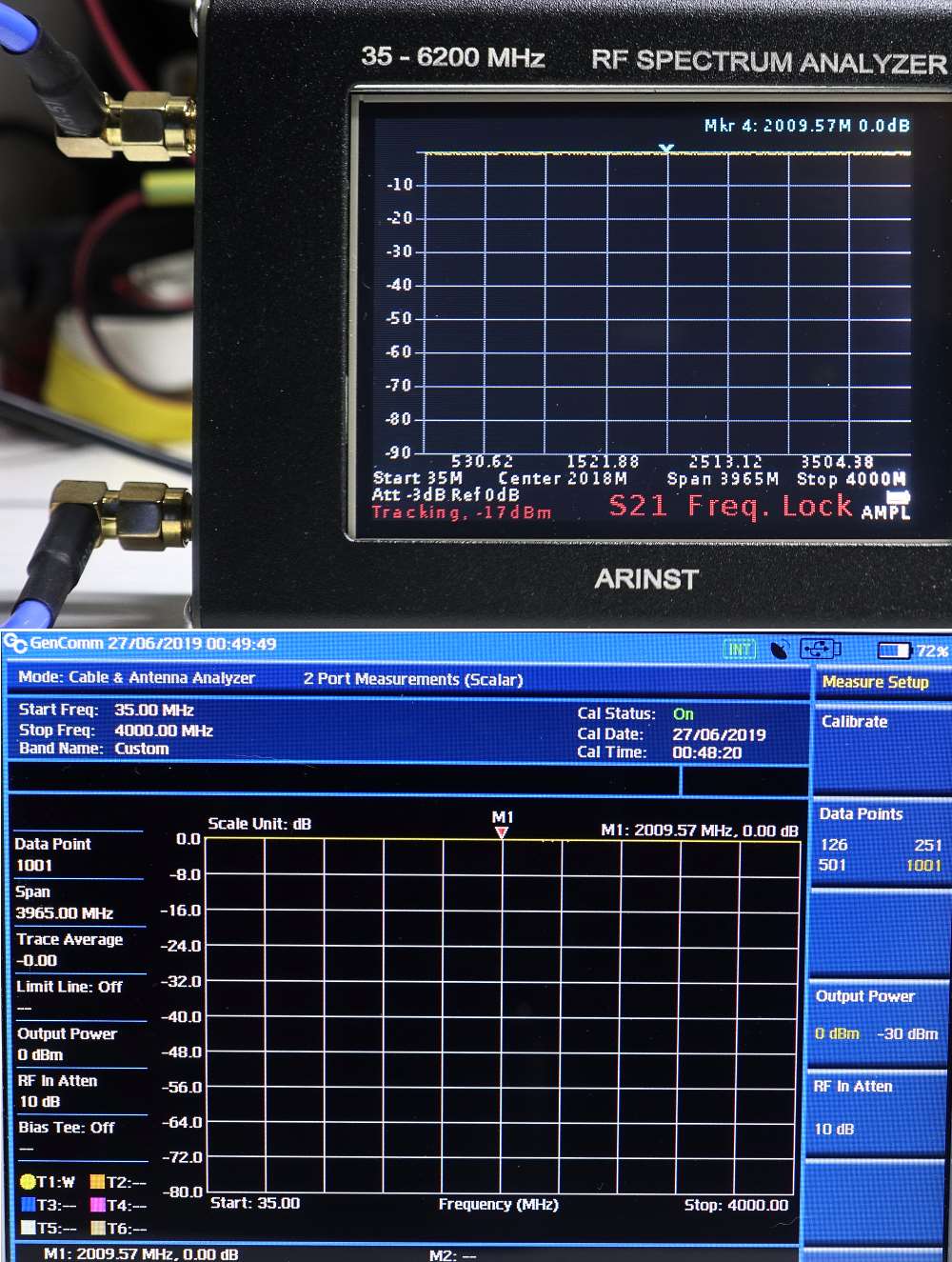
The sampling frequency was made median, in the center of the specified band, namely 2009.57 MHz. The number of scan points was also equal, 1000 + 1 each.
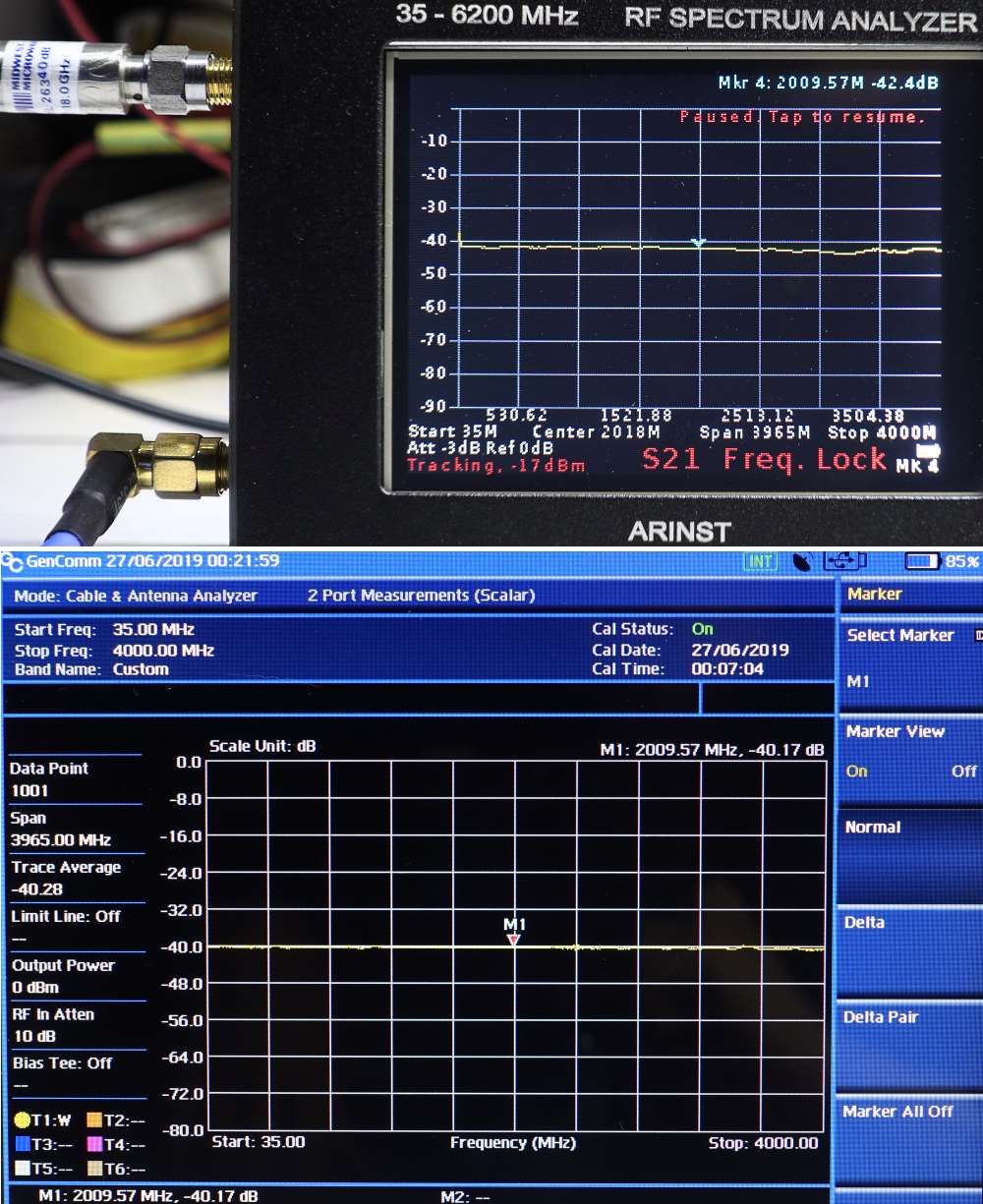
As you can see, the measurement result of the same instance of the attenuator at 40 dB, turned out to be close, but slightly different. Arinst SSA-TG R2 showed 42.4 dB, and GenCom 40.17 dB, ceteris paribus.
Attenuator 30 dB
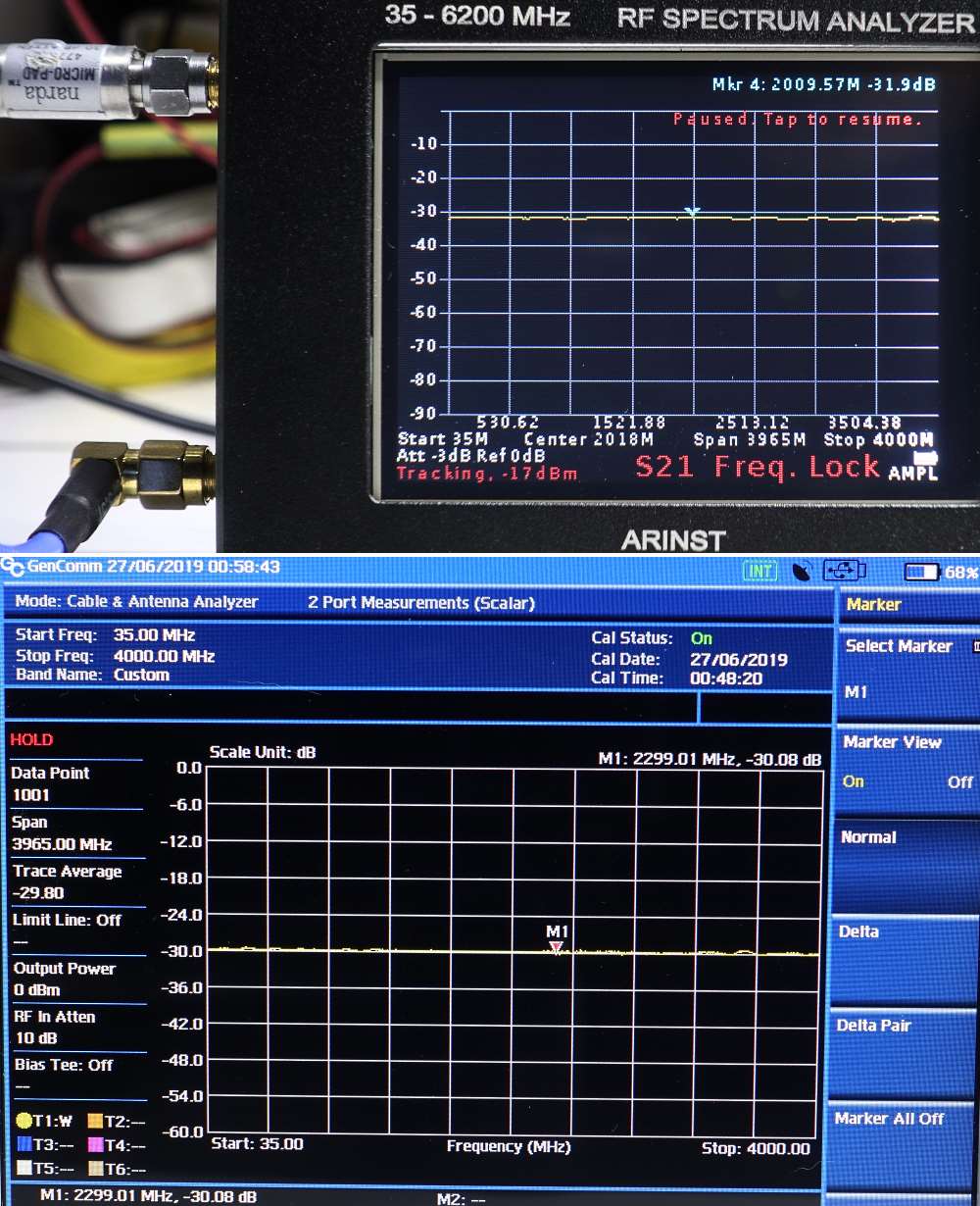
Arinst = 31.9 dB
GenCom = 30.08 dB
A roughly similar small variation in percentage was obtained when measuring other attenuators. But to save reader time and space in the article, they were not included in this review, since they are similar to the measurements presented above.
Min and max track
Despite the portability and simplicity of the device, nevertheless, manufacturers have added such a useful option as displaying cumulative minimums and maximums of changing tracks, which is in demand with various settings.
Three pictures collected in a gif picture, using an LPF filter of the 5.8 GHz band as an example, into the connection of which switching interference and disturbances were deliberately introduced:
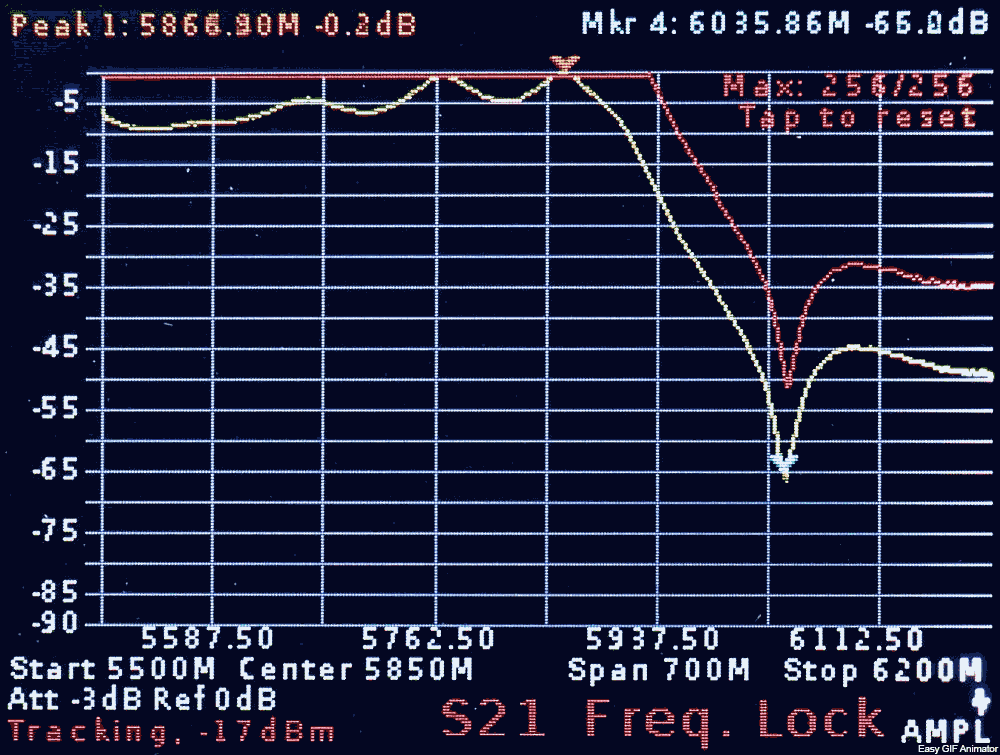
The yellow track is the current curve of the extreme sweep.
Red track - the maximums from past sweeps collected in memory.
The dark green track (after processing and compressing the pictures is gray) - respectively, the minima of the frequency response.
Antenna VSWR Measurement
As mentioned at the beginning of the review, this device has the ability to connect an external directional coupler (Direct coupler), or a measuring bridge offered separately (but only up to 2.7 GHz). The OSL calibration is programmatically provided to indicate to the device a reference point for VSWR.
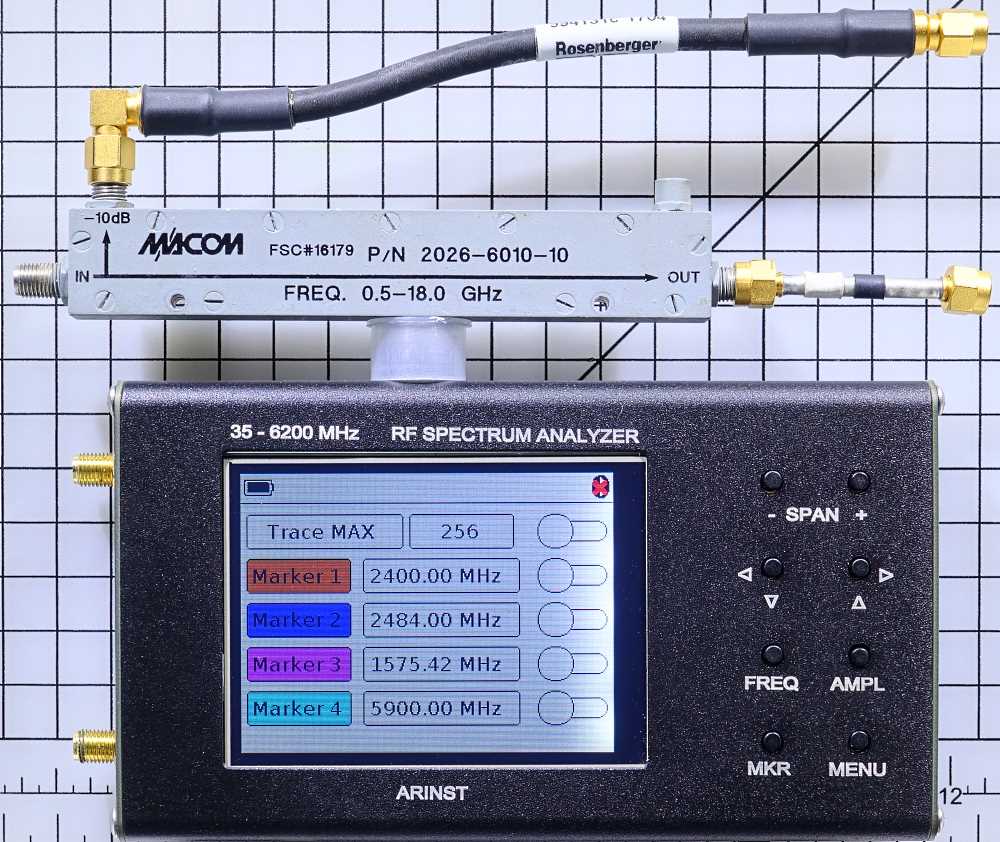
Shown here is a directional coupler with phase-stable measuring feeders, but already disconnected from the device after the completion of the SWR measurement. But here it is presented in the expanded position, so do not pay attention to the discrepancy to the apparent connection. The directional coupler is connected on the left to the device, but in a reversed marking. Then the supply of the incident wave from the generator (upper port) and the removal of the analyzer reflected at the input (lower port) will turn out correctly.
In the combined two photographs, an example of such a connection and the removal of the VSWR of the Clover type circular polarization antenna, range 5.8 GHz, previously measured above is shown.
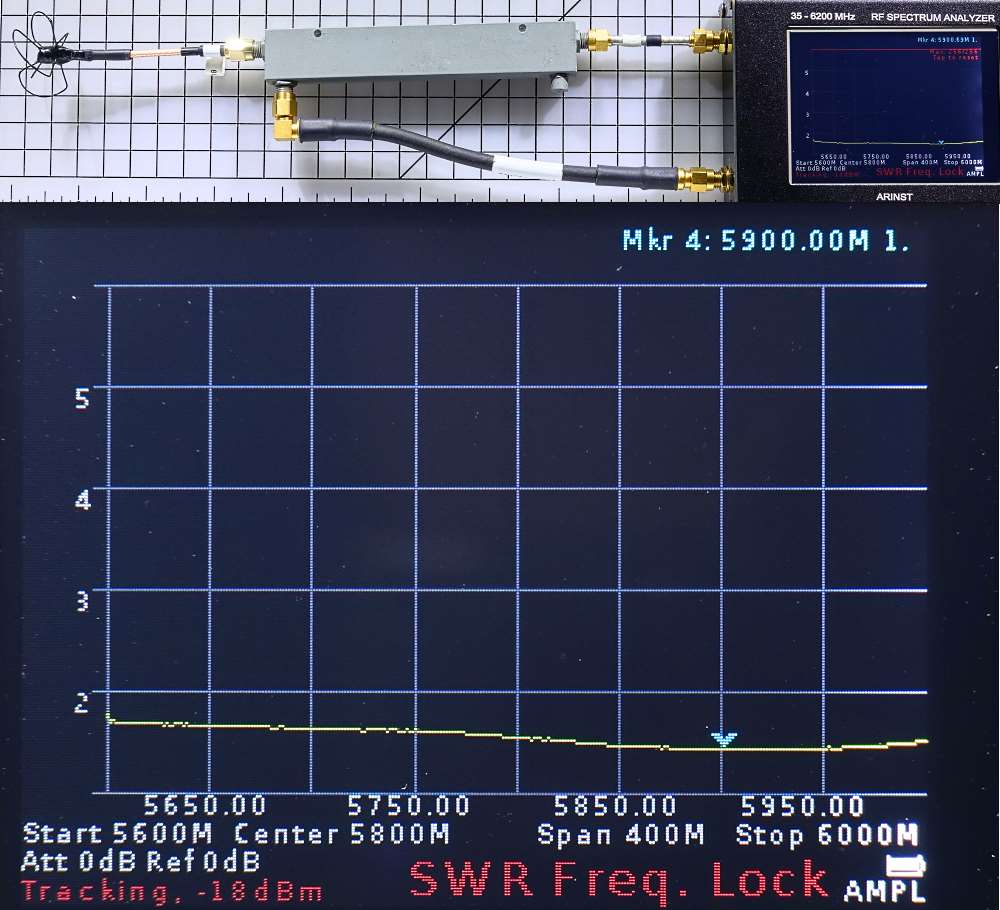
Since this possibility of measuring SWR is not among the main purposes of this device, but nevertheless to it (as can be seen from the picture of the readings of the display), there are still reasonable questions. A hard-set and unchangeable display scale of the VSWR graph, with a large value of as much as 6 units. Although the graph shows approximately the correct display of the VSWR curve of this antenna, but in the numerical value, for some reason, the exact value on the marker is not displayed at all, tenths and hundredths are not displayed. Only integer values are displayed, such as 1, 2, 3 ... There remains, as it were, the understatement of the measurement result.
Although for rough estimates, in order to generally understand a suitable antenna or on damage, it is very acceptable. But the fine-tuning in working with the antenna will be more difficult to do, although it is quite possible.
Integrated Generator Accuracy Measurement
Just like an OTDR, here also only 2 decimal places are declared in the TTX.
All the same, it is naive to expect from a budget-pocket device that there is a rubidium frequency standard on board. * smiley smile *
Nevertheless, the inquisitive reader will certainly be interested in the magnitude of the error in such a tiny generator. But since the attorney precision frequency counter was available only up to 250 MHz, he limited himself to viewing only 4 frequencies below the range, just to understand the error trend, if any. It should be noted that at higher frequencies, photographs were also prepared from another device. But to save space in the article, they were not included in this review either, because of the confirmation of the numerically the same percentage as a percentage of the error in the lower digits.
Four photos at four frequencies were collected in a gif picture, also to save space: 50.00; 100.00; 150.00 and 200.00 MHz
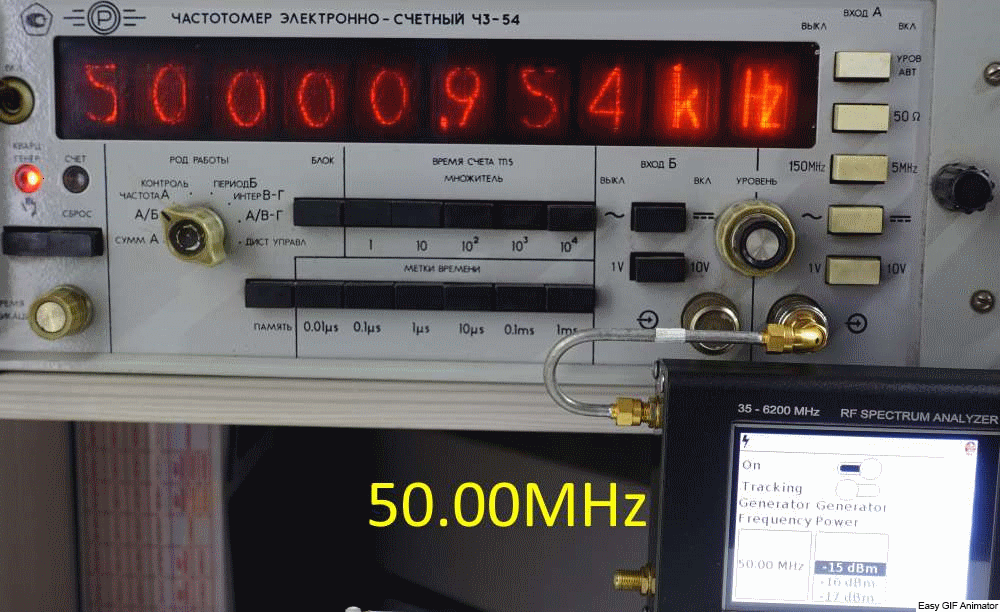
The trend and the magnitude of the available error are clearly visible:
50.00 MHz has a shallow excess of the oscillator frequency, namely 954 Hz.
100.00 MHz, respectively, a little more, +1.79 KHz.
150.00 MHz, even more +1.97 kHz
200.00 MHz, +3.78 KHz
Further up the frequency was measured by a GenCom analyzer, which turned out to be a good frequency counter. For example, if the generator built into GenCom missed 800 hertz at a frequency of 50.00 MHz, then not only the external frequency counter showed this, but the spectrum analyzer itself measured exactly the same:
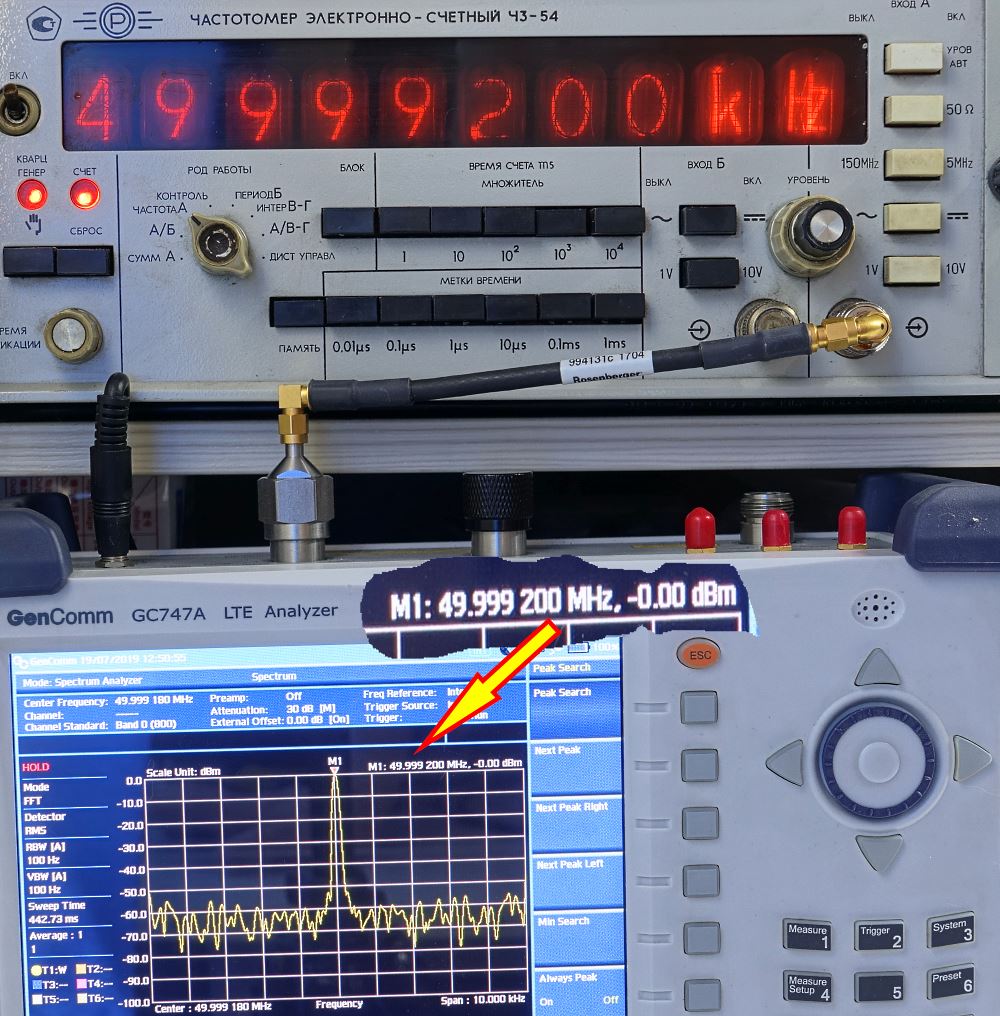
Next, one of the photos of the display, with the measured frequency of the generator built into the SSA-TG R2, using the example of the midpoint of the Wi-Fi range of 2450 MHz:
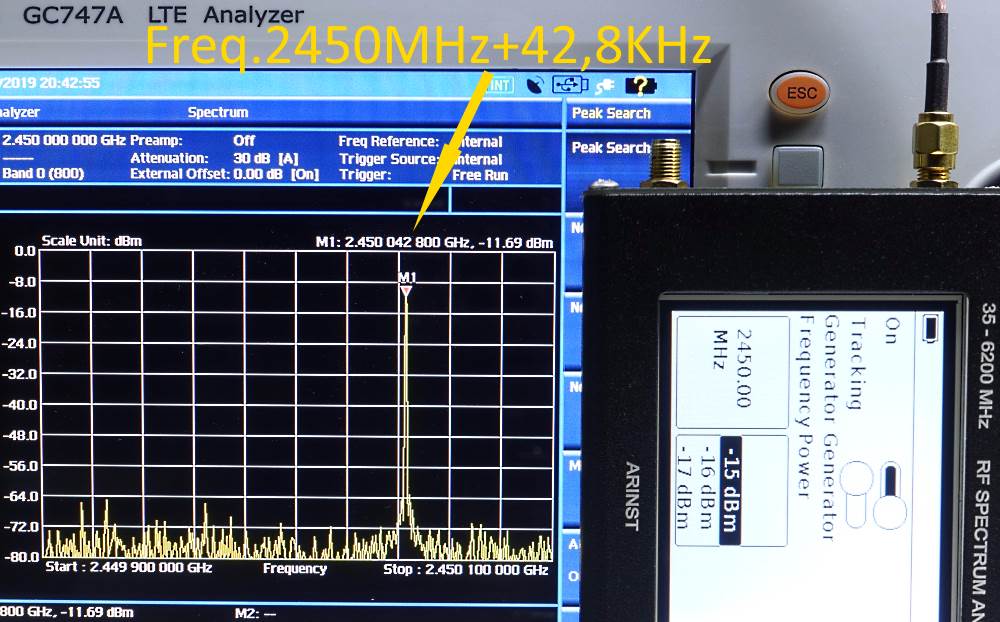
To reduce the space in the article, I also did not upload the other similar photographs of the display, instead they briefly squeezed the measurement results over the ranges above 200 MHz:
At a frequency of 433.00 MHz, the excess was +7.92 KHz.
At a frequency of 1200.00 MHz, = +22.4 KHz.
At a frequency of 2450.00 MHz, = +42.8 KHz (in the previous photo)
At a frequency of 3999.50 MHz, = +71.6 KHz.
But nevertheless, the two decimal places declared in the factory characteristics are clearly maintained across all ranges.
Signal amplitude measurement comparison
On the following gif picture, 6 photos are collected, where the Arinst SSA-TG R2 analyzer itself measures its own generator, at randomly selected six frequencies.
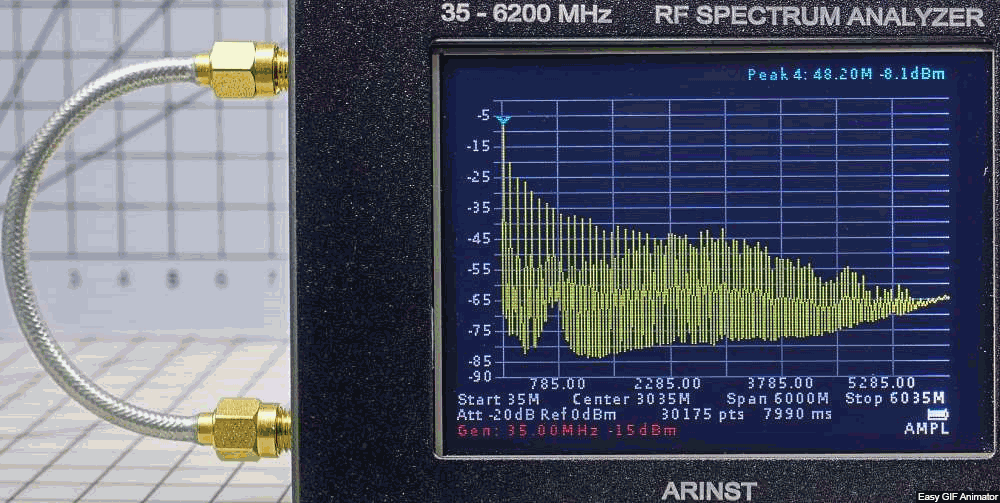
50 MHz -8.1 dBm; 200 MHz -9.0 dBm; 1000 MHz -9.6 dBm;
2500 MHz -9.1 dBm; 3999 MHz - 5.1 dBm; 5800 MHz -9.1 dBm
Although the declared maximum amplitude of the generator is not higher than minus 15 dBm, other values are actually visible.
To find out the reasons for such an indication of the amplitude, measurements were taken from an Arinst SSA-TG R2 generator, with an Anritsu MA24106A precision sensor, with calibration zeroing at a matched load, before starting measurements. Each time, a frequency value was also entered, for measurement accuracy taking into account the coefficients, according to the correction table sewn from the factory for frequency and temperature.
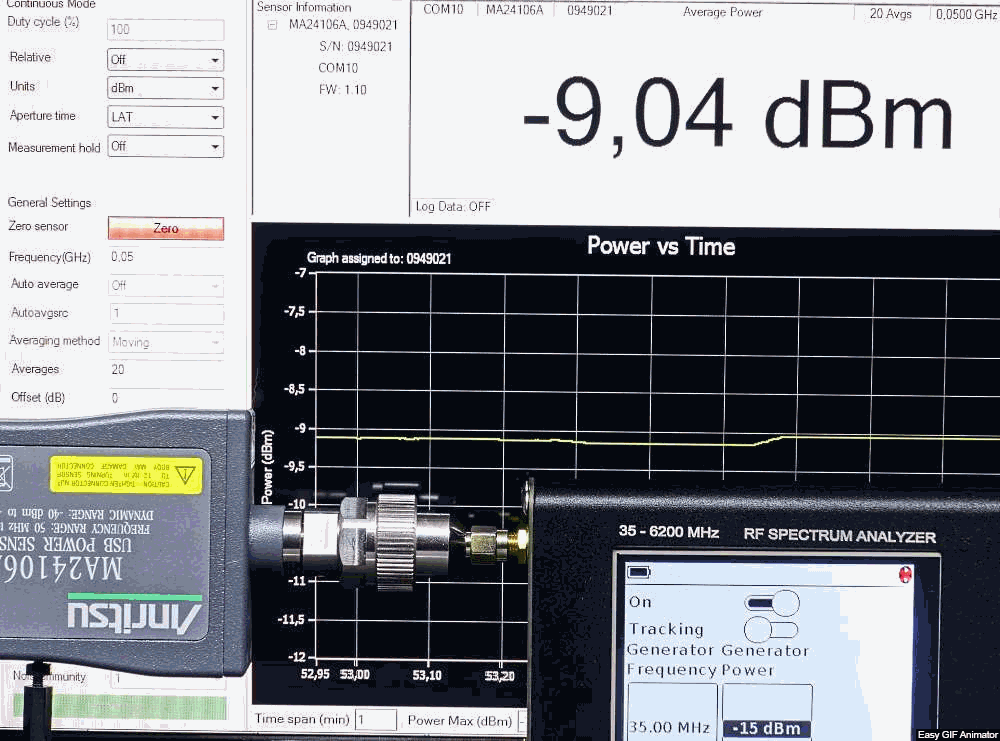
35 MHz -9.04 dBm; 200 MHz -9.12 dBm; 1000 MHz -9.06 dBm;
2500 MHz -8.96 dBm; 3999 MHz - 7.48 dBm; 5800 MHz -7.02 dBm
As you can see the amplitude of the signal generated by the generator integrated in the SSA-TG R2, the analyzer measures very worthily (for the amateur accuracy class). And the generator amplitude displayed at the bottom of the instrument’s display, it turns out that it’s simply “drawn”, since in reality it turned out it produces a higher level than it should in adjustable limits from -15 to -25 dBm.
There was doubt in the crept in, and whether the new Anritsu MA24106A sensor was not screwing up, specially made a comparison with another laboratory system analyzer from General Dynamics, model R2670B.
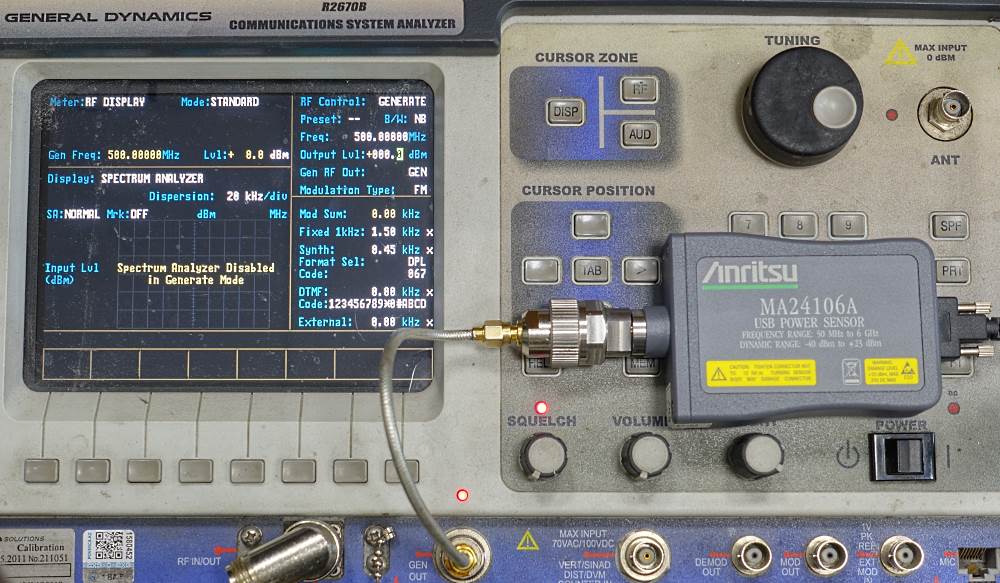
But no, the discrepancy in amplitude was not at all large, within 0.3 dBm.
The power meter on the GenCom 747A, also not far showed the available excess level from the generator:
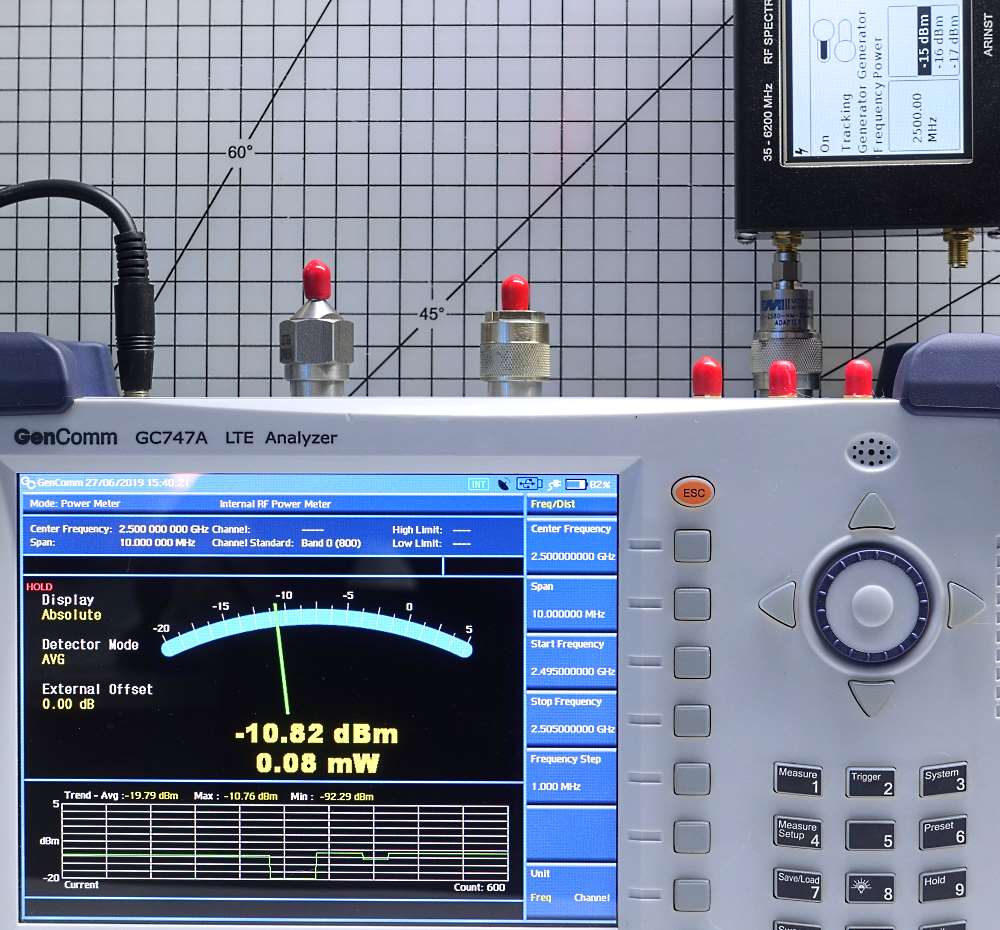
But at the level of 0 dBm, the Arinst SSA-TG R2 analyzer for some reason slightly exceeded the amplitude indicators, and from different signal sources with 0 dBm.
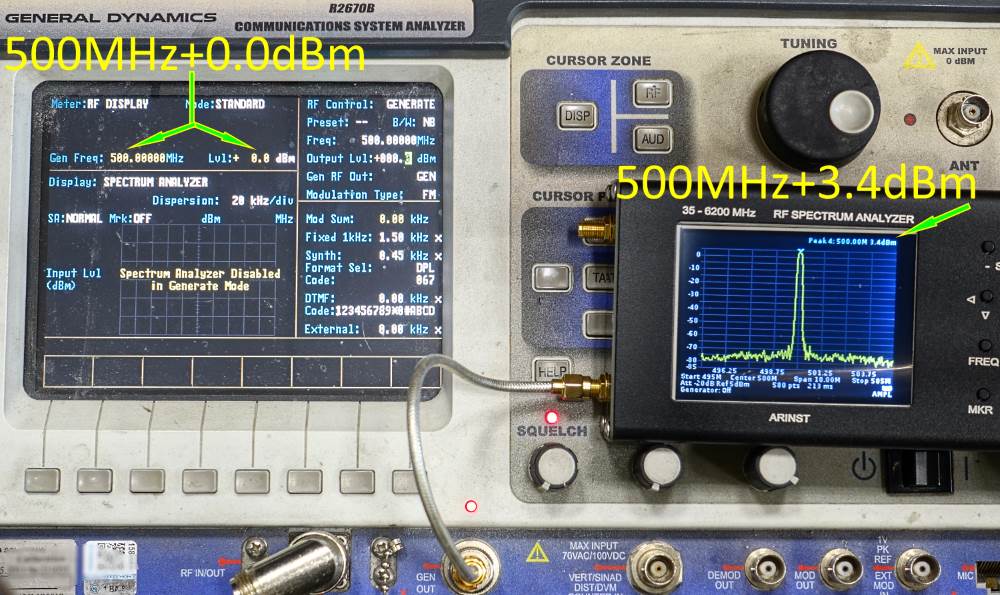
At the same time, the Anritsu MA24106A sensor shows 0.01 dBm from the Anritsu ML4803A calibrator
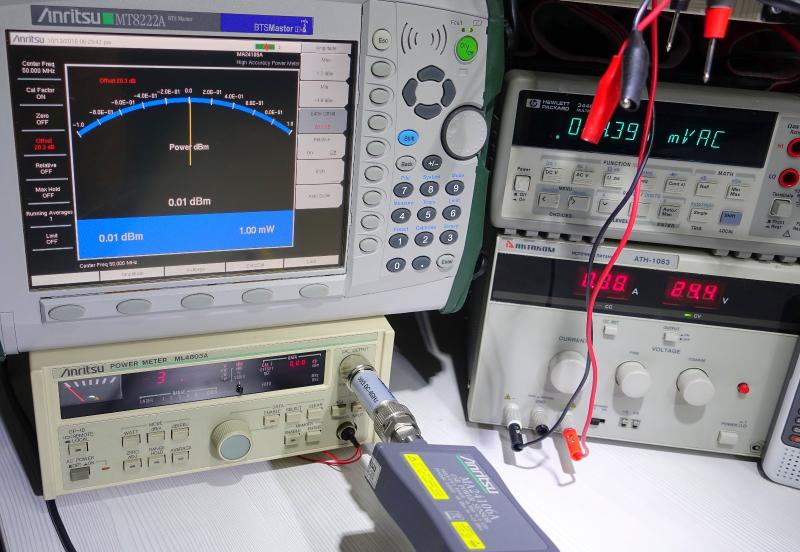
It seemed not very convenient to adjust the attenuator attenuation on the touchscreen with your finger, since the list ribbon skips, or often returns to its extreme value. It turned out to be more convenient and more accurate, for this, use the old-fashioned stylus:
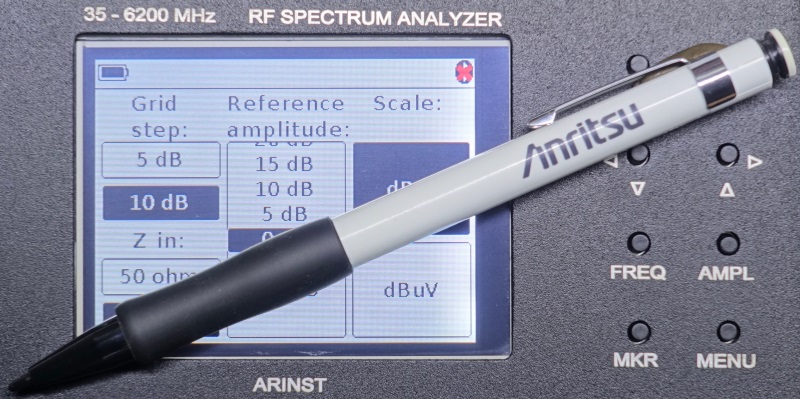
When viewing the harmonics of a low-frequency signal of 50 MHz, almost over the entire working band of the analyzer (up to 4 GHz), a certain “anomaly” was encountered at frequencies around 760 MHz:
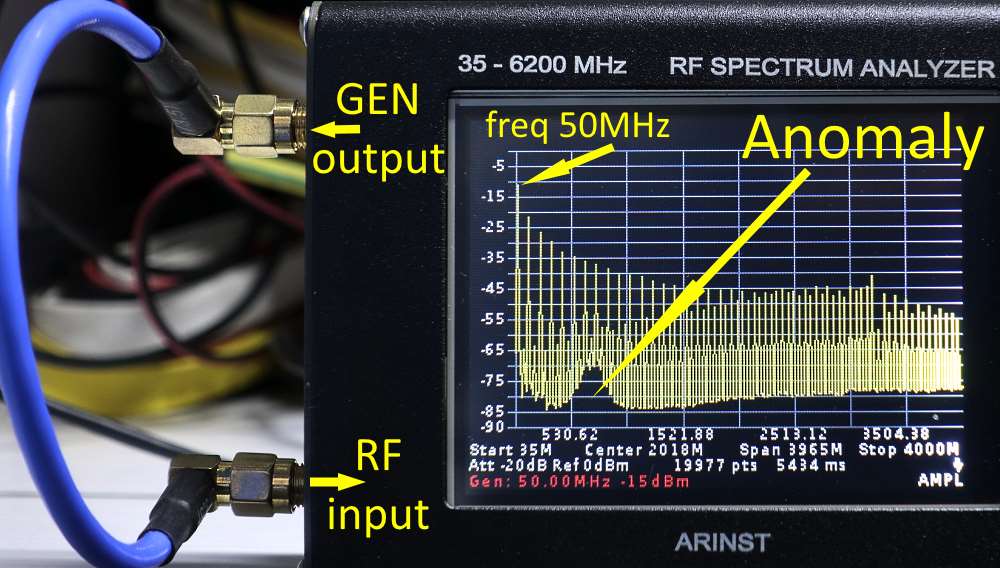
With a wider band at the upper frequency (up to 6035 MHz), so that Span would turn out exactly 6000 MHz, the anomaly is also noticeable:
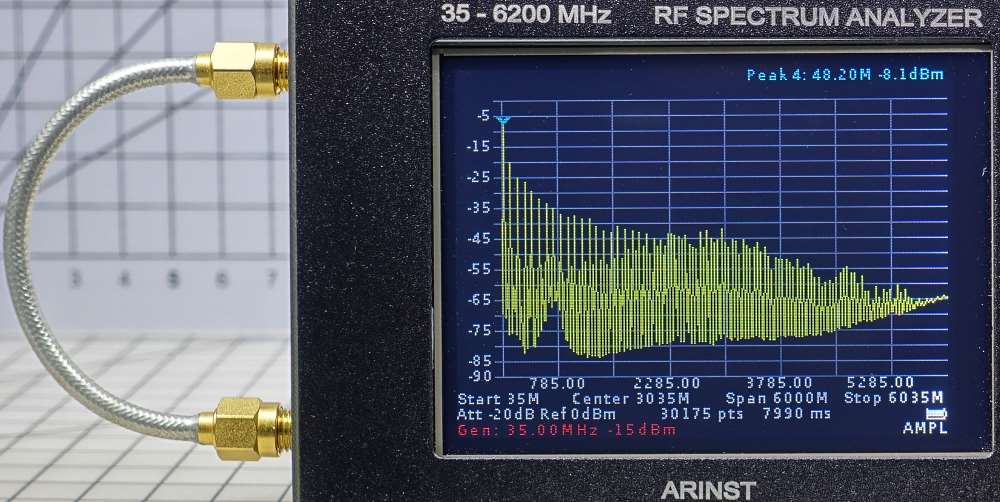
At the same time, the same signal from the same built-in generator in SSA-TG R2, when applied to another device, does not have such an anomaly:
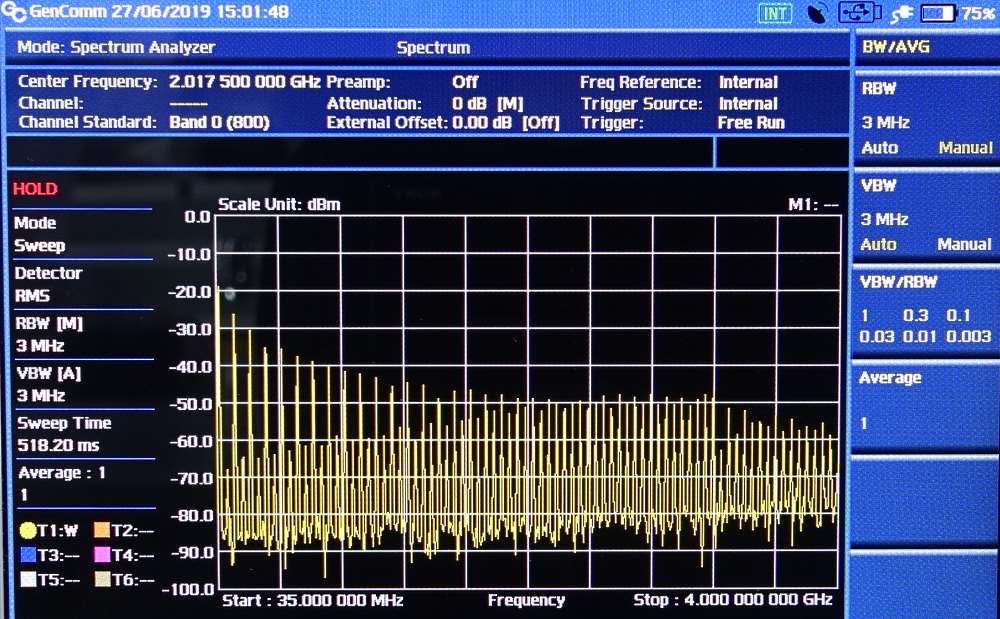
Since this anomaly was not noticed on another analyzer, it means that the problem is not in the generator, but in the spectrum analyzer.
The built-in attenuator for attenuating the amplitude of the generator, clearly attenuates in steps of 1 dB, all of its 10 steps. Here at the bottom of the screen you can clearly see the stepped track on the timeline, showing the attenuator performance:
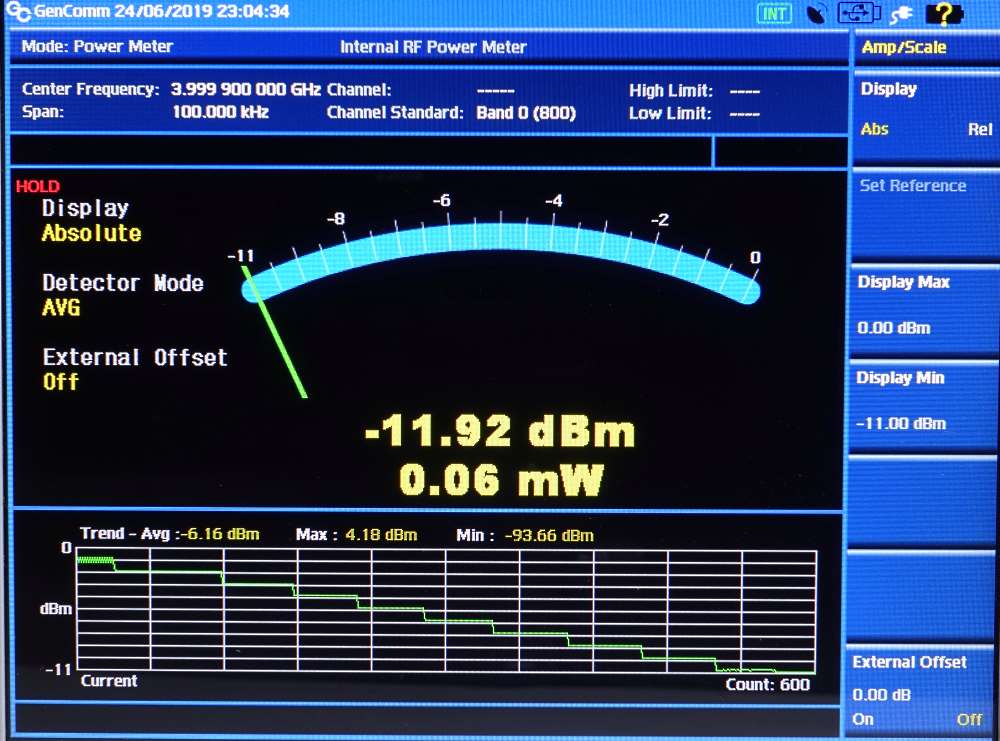
Leaving the generator output port and analyzer input port connected, he turned off the device. The next day I turned it on, I found a signal with normal harmonics at an interesting frequency of 777.00 MHz:
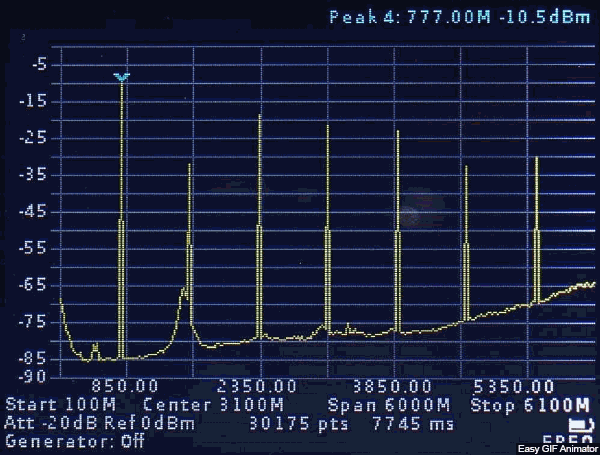
In this case, the generator was left turned off. Having checked the menu, it really turned out to be turned off. In theory, nothing should have appeared at the output of the generator, if on the eve it was turned off. I had to turn it on at any frequency in the generator menu, and turn it off right there. After this action, a strange frequency disappears and no longer appears itself, but only until the next time the entire device is turned on. Surely in the subsequent firmware, the manufacturer will fix such a self-inclusion at the output of the generator turned off. But if the cable between the ports is missing, then it is completely not noticeable that something is wrong, well, unless the shelf of noise is slightly higher. And after forcibly turning the generator on and off, the noise shelf slightly becomes lower, but by an inconspicuous amount. This is a minor operational minus, the solution of which takes an extra 3 seconds after turning on the device.
The interior of Arinst SSA-TG R2 is shown in three photos collected in gif:

Comparison of dimensions with the old Arinst SSA Pro spectrum analyzer, on which the smartphone is on top, as a display:
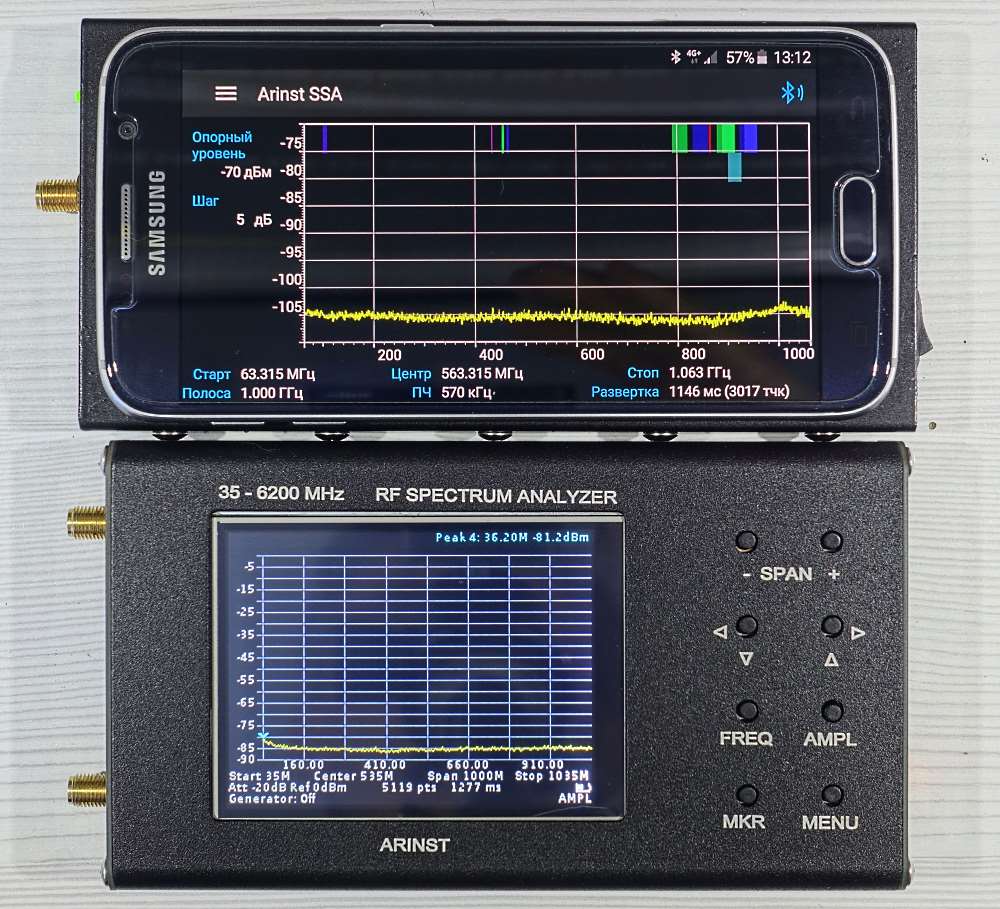
Pros:
As in the case of the Arinst VR 23-6200 reflectometer, which was previously reviewed by the reviewer, the Arinst SSA-TG R2 analyzer considered here is in exactly the same form factor and dimensions, a miniature, but quite serious assistant to the amateur radio amateur. Also not requiring as previous SSA models external displays, on a computer, or smartphone.
A very wide, solid and uninterrupted frequency band, from 35 to 6200 MHz.
I have not investigated the exact battery life, but the capacity of the built-in lithium battery is enough for a long battery life.
A rather insignificant error in measurements for an instrument of such a miniature class. In any case, for the amateur level - more than enough.
It is supported by the manufacturer, both by firmware and by physical repair, if necessary. It is already widely available for purchase, that is, not on order, as is sometimes the case with other manufacturers.
Cons were also seen:
Unaccounted for and not documented, spontaneous supply to the output of a signal generator with a frequency of 777.00 MHz. Surely, such a misunderstanding with the next firmware will be eliminated. Although if you know about this feature, it is easily eliminated in 3 seconds by simply turning the built-in generator on and off.
You need to get a little used to touchscreen, since not all virtual buttons turn on immediately with a slider if you shift them. But if you don’t move the sliders, but immediately poke into the final position, then everything works immediately clearly. This is probably not a minus, but rather a “feature” of the drawn controls, specifically in the menu of the generator and the slider for controlling the attenuator.
When connected via Bluetooth, the analyzer, as it were, successfully connects to the smartphone, but the frequency response graph does not output, such as the outdated SSA Pro. When connecting, all the requirements of the instructions were fully complied with, described in section 8 of the factory instructions.
It was thought that once the password is received, a confirmation of the connection is displayed on the smartphone screen, then this function is possible only for upgrading the firmware via the smartphone.But no.
Clause 8.2.6 clearly states:8.2.6. The device will connect to the tablet / smartphone, a graph of the signal spectrum and an information message about connecting to the ConnectedtoARINST_SSA device will appear on the screen, as in Figure 28. (c)Yes, confirmation appears, but the track doesn’t.Repeatedly reconnected, each time the track did not appear. And from the old SSA Pro, right instantly.Another disadvantage of the notorious “versatility”, due to restrictions on the lower edge of the operating frequencies, is not suitable for short-wave radio amateurs. For that, for RC FPV, completely and completely satisfy the needs of amateurs and pros, even more than that.Findings:
In general, both devices left very positive impressions, since in essence they provide a complete measuring complex, at least even for the level of advanced amateur radio enthusiasts. Pricing policy is not considered here, but nevertheless, it is noticeably lower than other closest analogues on the market in such a wide and continuous frequency band that it cannot but rejoice.The aim of the review was simply to compare these testers with more advanced measuring equipment, and to provide readers with photo-documented displays, to form their own opinions and make their own decisions about the possibility of acquisition. In no case was it pursued any advertising goals. Only third-party assessment and publication of observation results.